Training & Assessment Cluster 5 Curriculum- Common Program
VerifiedAdded on 2022/08/23
|31
|8715
|20
AI Summary
Contribute Materials
Your contribution can guide someone’s learning journey. Share your
documents today.
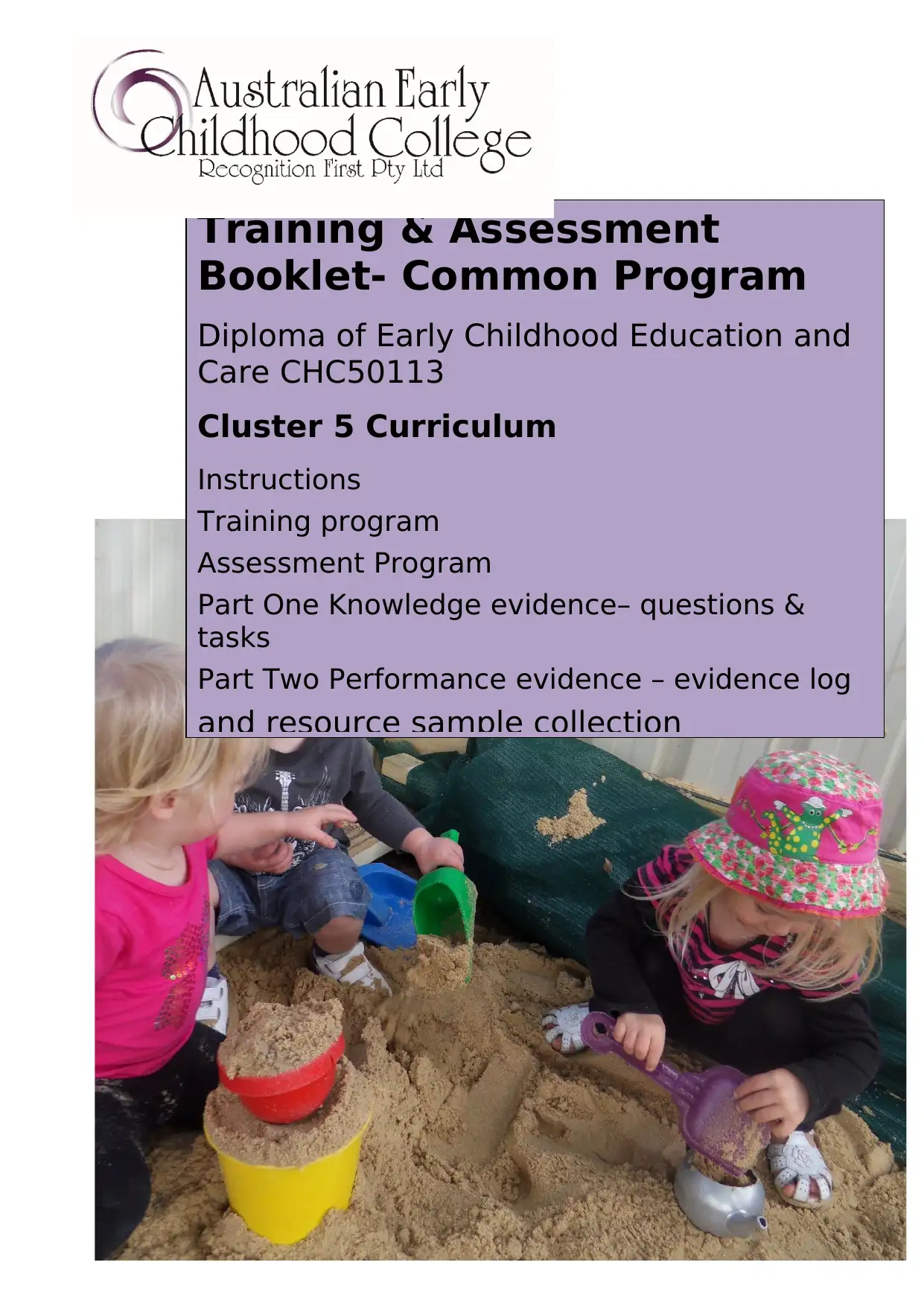
Training & Assessment
Booklet- Common Program
Diploma of Early Childhood Education and
Care CHC50113
Cluster 5 Curriculum
Instructions
Training program
Assessment Program
Part One Knowledge evidence– questions &
tasks
Part Two Performance evidence – evidence log
and resource sample collection
Booklet- Common Program
Diploma of Early Childhood Education and
Care CHC50113
Cluster 5 Curriculum
Instructions
Training program
Assessment Program
Part One Knowledge evidence– questions &
tasks
Part Two Performance evidence – evidence log
and resource sample collection
Secure Best Marks with AI Grader
Need help grading? Try our AI Grader for instant feedback on your assignments.
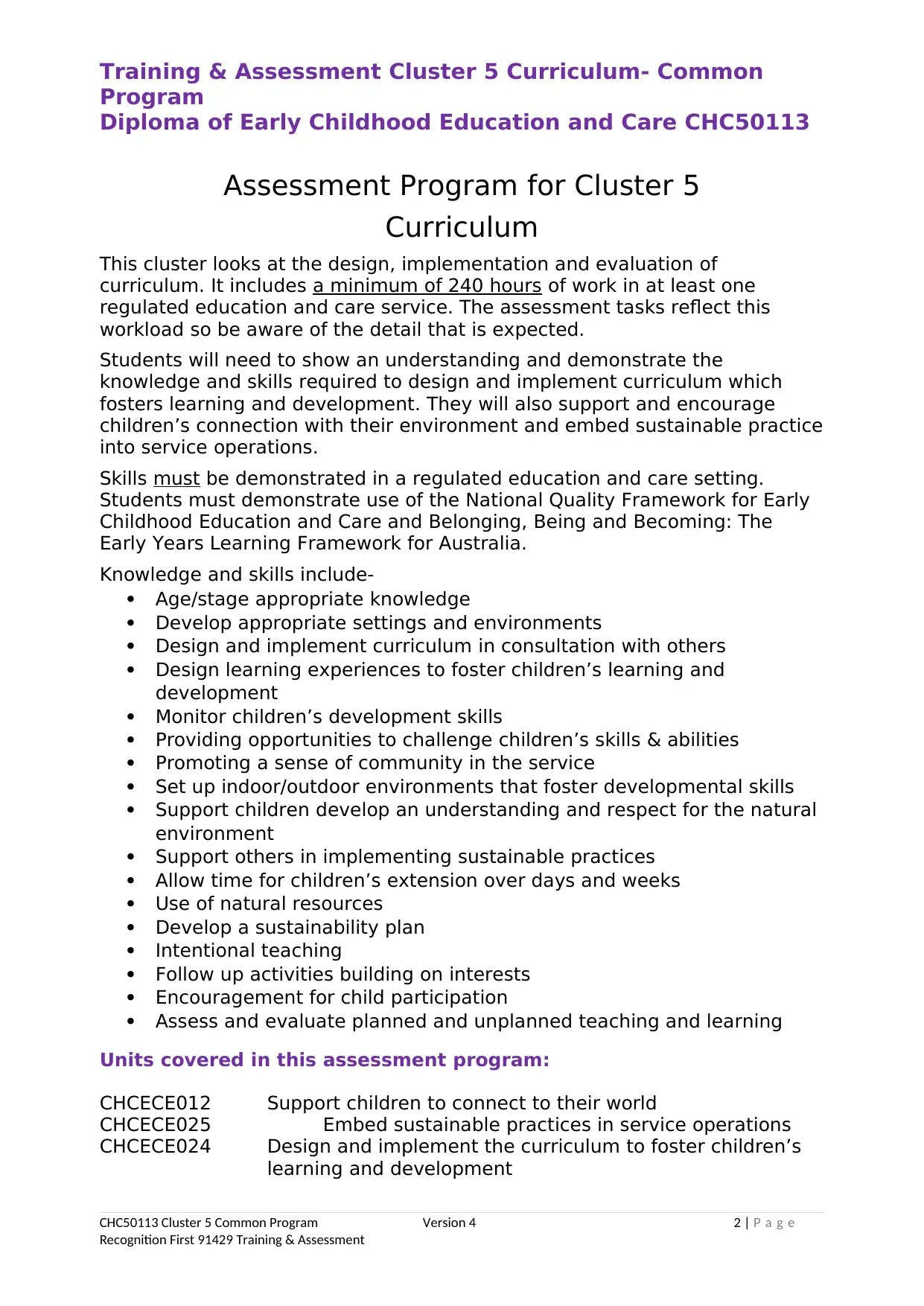
Training & Assessment Cluster 5 Curriculum- Common
Program
Diploma of Early Childhood Education and Care CHC50113
Assessment Program for Cluster 5
Curriculum
This cluster looks at the design, implementation and evaluation of
curriculum. It includes a minimum of 240 hours of work in at least one
regulated education and care service. The assessment tasks reflect this
workload so be aware of the detail that is expected.
Students will need to show an understanding and demonstrate the
knowledge and skills required to design and implement curriculum which
fosters learning and development. They will also support and encourage
children’s connection with their environment and embed sustainable practice
into service operations.
Skills must be demonstrated in a regulated education and care setting.
Students must demonstrate use of the National Quality Framework for Early
Childhood Education and Care and Belonging, Being and Becoming: The
Early Years Learning Framework for Australia.
Knowledge and skills include-
Age/stage appropriate knowledge
Develop appropriate settings and environments
Design and implement curriculum in consultation with others
Design learning experiences to foster children’s learning and
development
Monitor children’s development skills
Providing opportunities to challenge children’s skills & abilities
Promoting a sense of community in the service
Set up indoor/outdoor environments that foster developmental skills
Support children develop an understanding and respect for the natural
environment
Support others in implementing sustainable practices
Allow time for children’s extension over days and weeks
Use of natural resources
Develop a sustainability plan
Intentional teaching
Follow up activities building on interests
Encouragement for child participation
Assess and evaluate planned and unplanned teaching and learning
Units covered in this assessment program:
CHCECE012 Support children to connect to their world
CHCECE025 Embed sustainable practices in service operations
CHCECE024 Design and implement the curriculum to foster children’s
learning and development
CHC50113 Cluster 5 Common Program Version 4 2 | P a g e
Recognition First 91429 Training & Assessment
Program
Diploma of Early Childhood Education and Care CHC50113
Assessment Program for Cluster 5
Curriculum
This cluster looks at the design, implementation and evaluation of
curriculum. It includes a minimum of 240 hours of work in at least one
regulated education and care service. The assessment tasks reflect this
workload so be aware of the detail that is expected.
Students will need to show an understanding and demonstrate the
knowledge and skills required to design and implement curriculum which
fosters learning and development. They will also support and encourage
children’s connection with their environment and embed sustainable practice
into service operations.
Skills must be demonstrated in a regulated education and care setting.
Students must demonstrate use of the National Quality Framework for Early
Childhood Education and Care and Belonging, Being and Becoming: The
Early Years Learning Framework for Australia.
Knowledge and skills include-
Age/stage appropriate knowledge
Develop appropriate settings and environments
Design and implement curriculum in consultation with others
Design learning experiences to foster children’s learning and
development
Monitor children’s development skills
Providing opportunities to challenge children’s skills & abilities
Promoting a sense of community in the service
Set up indoor/outdoor environments that foster developmental skills
Support children develop an understanding and respect for the natural
environment
Support others in implementing sustainable practices
Allow time for children’s extension over days and weeks
Use of natural resources
Develop a sustainability plan
Intentional teaching
Follow up activities building on interests
Encouragement for child participation
Assess and evaluate planned and unplanned teaching and learning
Units covered in this assessment program:
CHCECE012 Support children to connect to their world
CHCECE025 Embed sustainable practices in service operations
CHCECE024 Design and implement the curriculum to foster children’s
learning and development
CHC50113 Cluster 5 Common Program Version 4 2 | P a g e
Recognition First 91429 Training & Assessment
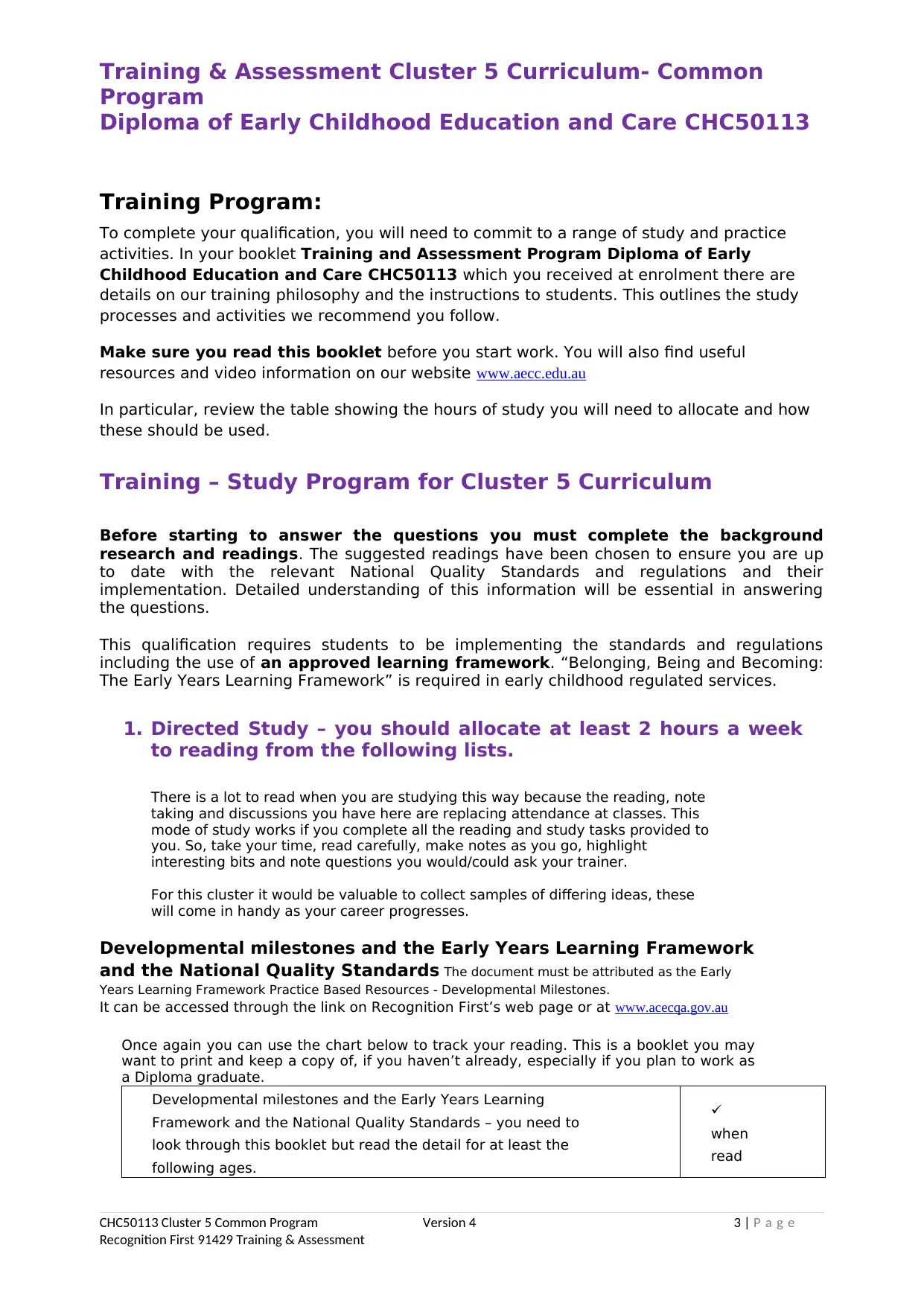
Training & Assessment Cluster 5 Curriculum- Common
Program
Diploma of Early Childhood Education and Care CHC50113
Training Program:
To complete your qualification, you will need to commit to a range of study and practice
activities. In your booklet Training and Assessment Program Diploma of Early
Childhood Education and Care CHC50113 which you received at enrolment there are
details on our training philosophy and the instructions to students. This outlines the study
processes and activities we recommend you follow.
Make sure you read this booklet before you start work. You will also find useful
resources and video information on our website www.aecc.edu.au
In particular, review the table showing the hours of study you will need to allocate and how
these should be used.
Training – Study Program for Cluster 5 Curriculum
Before starting to answer the questions you must complete the background
research and readings. The suggested readings have been chosen to ensure you are up
to date with the relevant National Quality Standards and regulations and their
implementation. Detailed understanding of this information will be essential in answering
the questions.
This qualification requires students to be implementing the standards and regulations
including the use of an approved learning framework. “Belonging, Being and Becoming:
The Early Years Learning Framework” is required in early childhood regulated services.
1. Directed Study – you should allocate at least 2 hours a week
to reading from the following lists.
There is a lot to read when you are studying this way because the reading, note
taking and discussions you have here are replacing attendance at classes. This
mode of study works if you complete all the reading and study tasks provided to
you. So, take your time, read carefully, make notes as you go, highlight
interesting bits and note questions you would/could ask your trainer.
For this cluster it would be valuable to collect samples of differing ideas, these
will come in handy as your career progresses.
Developmental milestones and the Early Years Learning Framework
and the National Quality Standards The document must be attributed as the Early
Years Learning Framework Practice Based Resources - Developmental Milestones.
It can be accessed through the link on Recognition First’s web page or at www.acecqa.gov.au
Once again you can use the chart below to track your reading. This is a booklet you may
want to print and keep a copy of, if you haven’t already, especially if you plan to work as
a Diploma graduate.
Developmental milestones and the Early Years Learning
Framework and the National Quality Standards – you need to
look through this booklet but read the detail for at least the
following ages.
when
read
CHC50113 Cluster 5 Common Program Version 4 3 | P a g e
Recognition First 91429 Training & Assessment
Program
Diploma of Early Childhood Education and Care CHC50113
Training Program:
To complete your qualification, you will need to commit to a range of study and practice
activities. In your booklet Training and Assessment Program Diploma of Early
Childhood Education and Care CHC50113 which you received at enrolment there are
details on our training philosophy and the instructions to students. This outlines the study
processes and activities we recommend you follow.
Make sure you read this booklet before you start work. You will also find useful
resources and video information on our website www.aecc.edu.au
In particular, review the table showing the hours of study you will need to allocate and how
these should be used.
Training – Study Program for Cluster 5 Curriculum
Before starting to answer the questions you must complete the background
research and readings. The suggested readings have been chosen to ensure you are up
to date with the relevant National Quality Standards and regulations and their
implementation. Detailed understanding of this information will be essential in answering
the questions.
This qualification requires students to be implementing the standards and regulations
including the use of an approved learning framework. “Belonging, Being and Becoming:
The Early Years Learning Framework” is required in early childhood regulated services.
1. Directed Study – you should allocate at least 2 hours a week
to reading from the following lists.
There is a lot to read when you are studying this way because the reading, note
taking and discussions you have here are replacing attendance at classes. This
mode of study works if you complete all the reading and study tasks provided to
you. So, take your time, read carefully, make notes as you go, highlight
interesting bits and note questions you would/could ask your trainer.
For this cluster it would be valuable to collect samples of differing ideas, these
will come in handy as your career progresses.
Developmental milestones and the Early Years Learning Framework
and the National Quality Standards The document must be attributed as the Early
Years Learning Framework Practice Based Resources - Developmental Milestones.
It can be accessed through the link on Recognition First’s web page or at www.acecqa.gov.au
Once again you can use the chart below to track your reading. This is a booklet you may
want to print and keep a copy of, if you haven’t already, especially if you plan to work as
a Diploma graduate.
Developmental milestones and the Early Years Learning
Framework and the National Quality Standards – you need to
look through this booklet but read the detail for at least the
following ages.
when
read
CHC50113 Cluster 5 Common Program Version 4 3 | P a g e
Recognition First 91429 Training & Assessment
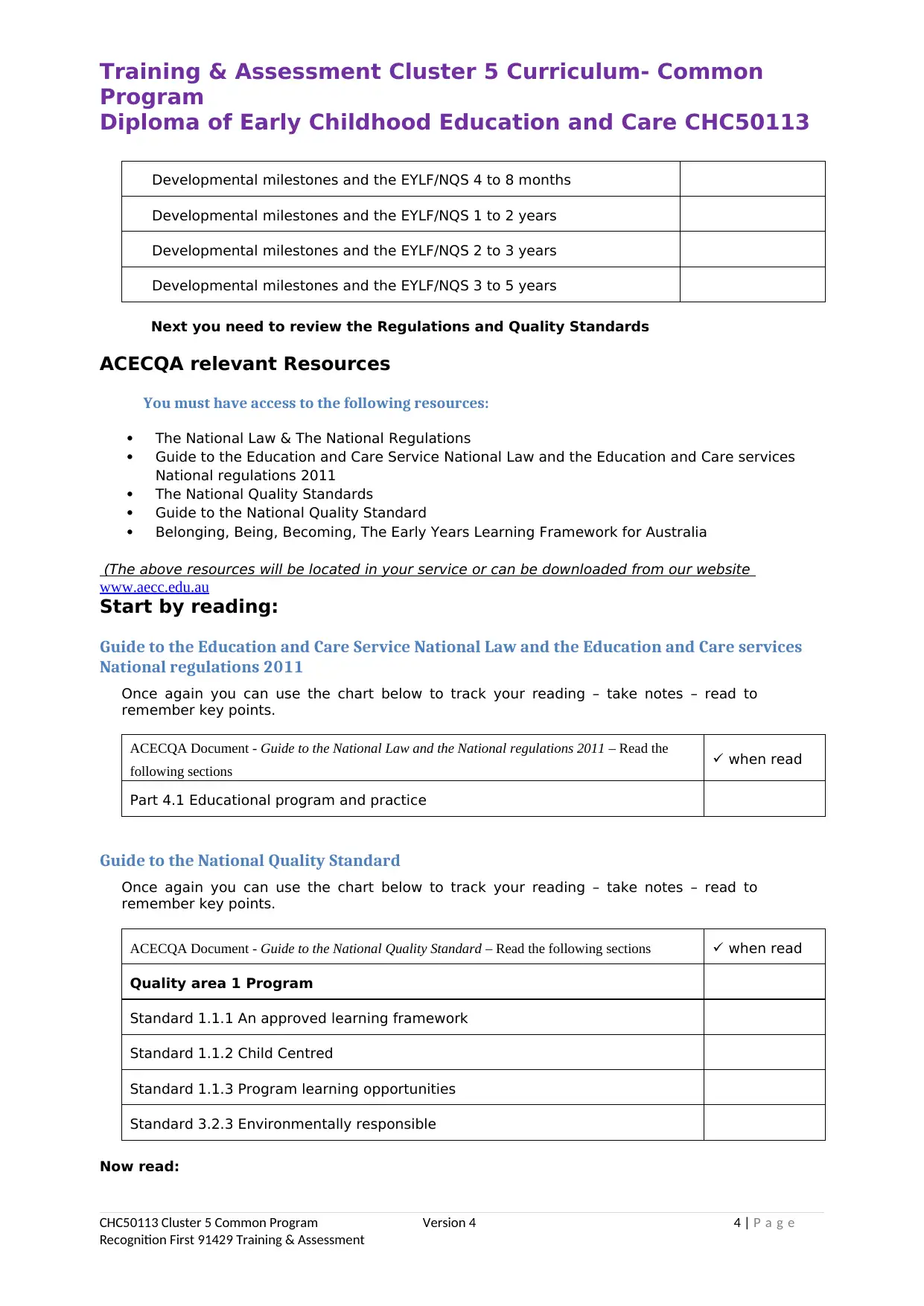
Training & Assessment Cluster 5 Curriculum- Common
Program
Diploma of Early Childhood Education and Care CHC50113
Developmental milestones and the EYLF/NQS 4 to 8 months
Developmental milestones and the EYLF/NQS 1 to 2 years
Developmental milestones and the EYLF/NQS 2 to 3 years
Developmental milestones and the EYLF/NQS 3 to 5 years
Next you need to review the Regulations and Quality Standards
ACECQA relevant Resources
You must have access to the following resources:
The National Law & The National Regulations
Guide to the Education and Care Service National Law and the Education and Care services
National regulations 2011
The National Quality Standards
Guide to the National Quality Standard
Belonging, Being, Becoming, The Early Years Learning Framework for Australia
(The above resources will be located in your service or can be downloaded from our website
www.aecc.edu.au
Start by reading:
Guide to the Education and Care Service National Law and the Education and Care services
National regulations 2011
Once again you can use the chart below to track your reading – take notes – read to
remember key points.
ACECQA Document - Guide to the National Law and the National regulations 2011 – Read the
following sections when read
Part 4.1 Educational program and practice
Guide to the National Quality Standard
Once again you can use the chart below to track your reading – take notes – read to
remember key points.
ACECQA Document - Guide to the National Quality Standard – Read the following sections when read
Quality area 1 Program
Standard 1.1.1 An approved learning framework
Standard 1.1.2 Child Centred
Standard 1.1.3 Program learning opportunities
Standard 3.2.3 Environmentally responsible
Now read:
CHC50113 Cluster 5 Common Program Version 4 4 | P a g e
Recognition First 91429 Training & Assessment
Program
Diploma of Early Childhood Education and Care CHC50113
Developmental milestones and the EYLF/NQS 4 to 8 months
Developmental milestones and the EYLF/NQS 1 to 2 years
Developmental milestones and the EYLF/NQS 2 to 3 years
Developmental milestones and the EYLF/NQS 3 to 5 years
Next you need to review the Regulations and Quality Standards
ACECQA relevant Resources
You must have access to the following resources:
The National Law & The National Regulations
Guide to the Education and Care Service National Law and the Education and Care services
National regulations 2011
The National Quality Standards
Guide to the National Quality Standard
Belonging, Being, Becoming, The Early Years Learning Framework for Australia
(The above resources will be located in your service or can be downloaded from our website
www.aecc.edu.au
Start by reading:
Guide to the Education and Care Service National Law and the Education and Care services
National regulations 2011
Once again you can use the chart below to track your reading – take notes – read to
remember key points.
ACECQA Document - Guide to the National Law and the National regulations 2011 – Read the
following sections when read
Part 4.1 Educational program and practice
Guide to the National Quality Standard
Once again you can use the chart below to track your reading – take notes – read to
remember key points.
ACECQA Document - Guide to the National Quality Standard – Read the following sections when read
Quality area 1 Program
Standard 1.1.1 An approved learning framework
Standard 1.1.2 Child Centred
Standard 1.1.3 Program learning opportunities
Standard 3.2.3 Environmentally responsible
Now read:
CHC50113 Cluster 5 Common Program Version 4 4 | P a g e
Recognition First 91429 Training & Assessment
Secure Best Marks with AI Grader
Need help grading? Try our AI Grader for instant feedback on your assignments.
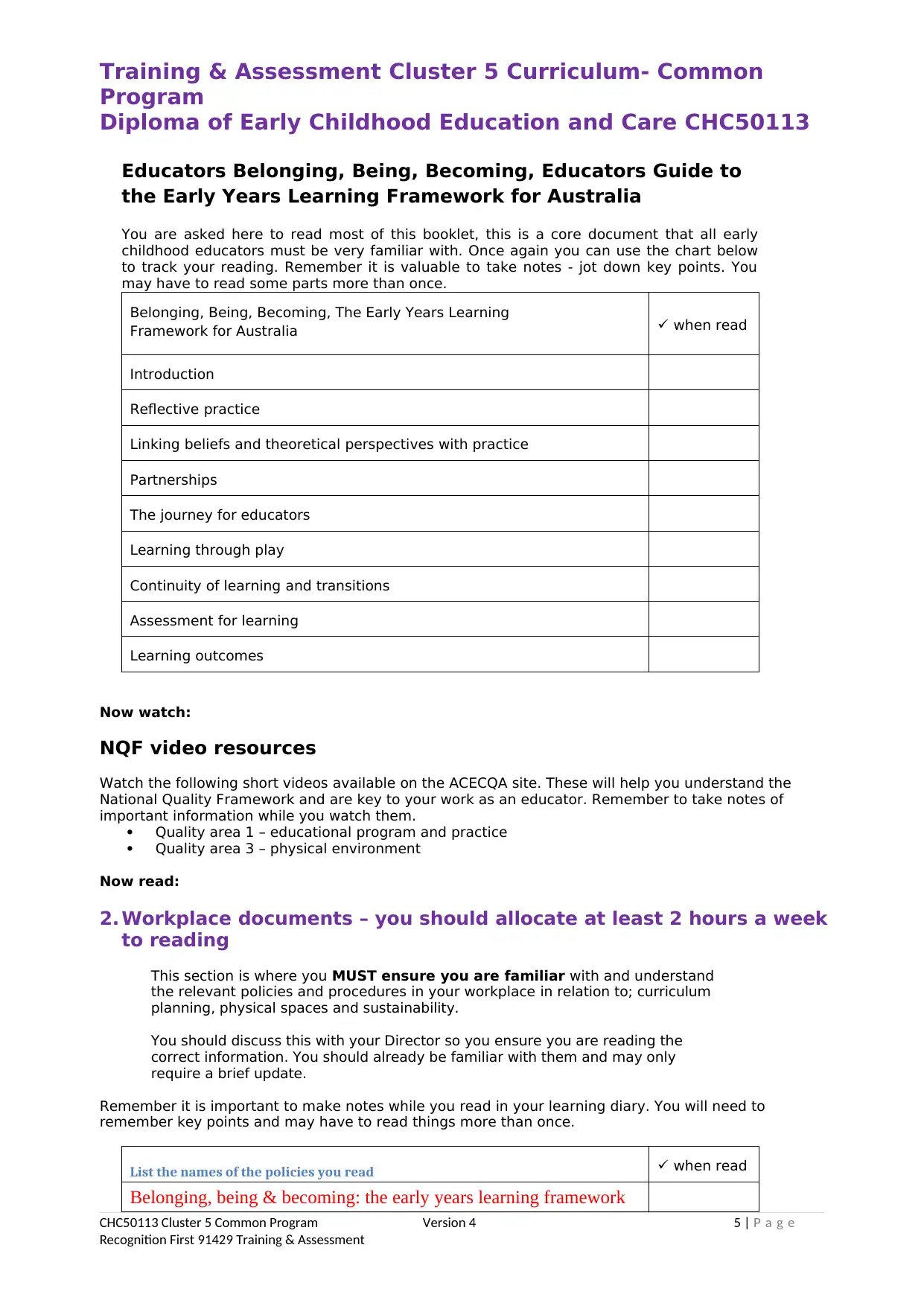
Training & Assessment Cluster 5 Curriculum- Common
Program
Diploma of Early Childhood Education and Care CHC50113
Educators Belonging, Being, Becoming, Educators Guide to
the Early Years Learning Framework for Australia
You are asked here to read most of this booklet, this is a core document that all early
childhood educators must be very familiar with. Once again you can use the chart below
to track your reading. Remember it is valuable to take notes - jot down key points. You
may have to read some parts more than once.
Belonging, Being, Becoming, The Early Years Learning
Framework for Australia when read
Introduction
Reflective practice
Linking beliefs and theoretical perspectives with practice
Partnerships
The journey for educators
Learning through play
Continuity of learning and transitions
Assessment for learning
Learning outcomes
Now watch:
NQF video resources
Watch the following short videos available on the ACECQA site. These will help you understand the
National Quality Framework and are key to your work as an educator. Remember to take notes of
important information while you watch them.
Quality area 1 – educational program and practice
Quality area 3 – physical environment
Now read:
2. Workplace documents – you should allocate at least 2 hours a week
to reading
This section is where you MUST ensure you are familiar with and understand
the relevant policies and procedures in your workplace in relation to; curriculum
planning, physical spaces and sustainability.
You should discuss this with your Director so you ensure you are reading the
correct information. You should already be familiar with them and may only
require a brief update.
Remember it is important to make notes while you read in your learning diary. You will need to
remember key points and may have to read things more than once.
List the names of the policies you read when read
Belonging, being & becoming: the early years learning framework
CHC50113 Cluster 5 Common Program Version 4 5 | P a g e
Recognition First 91429 Training & Assessment
Program
Diploma of Early Childhood Education and Care CHC50113
Educators Belonging, Being, Becoming, Educators Guide to
the Early Years Learning Framework for Australia
You are asked here to read most of this booklet, this is a core document that all early
childhood educators must be very familiar with. Once again you can use the chart below
to track your reading. Remember it is valuable to take notes - jot down key points. You
may have to read some parts more than once.
Belonging, Being, Becoming, The Early Years Learning
Framework for Australia when read
Introduction
Reflective practice
Linking beliefs and theoretical perspectives with practice
Partnerships
The journey for educators
Learning through play
Continuity of learning and transitions
Assessment for learning
Learning outcomes
Now watch:
NQF video resources
Watch the following short videos available on the ACECQA site. These will help you understand the
National Quality Framework and are key to your work as an educator. Remember to take notes of
important information while you watch them.
Quality area 1 – educational program and practice
Quality area 3 – physical environment
Now read:
2. Workplace documents – you should allocate at least 2 hours a week
to reading
This section is where you MUST ensure you are familiar with and understand
the relevant policies and procedures in your workplace in relation to; curriculum
planning, physical spaces and sustainability.
You should discuss this with your Director so you ensure you are reading the
correct information. You should already be familiar with them and may only
require a brief update.
Remember it is important to make notes while you read in your learning diary. You will need to
remember key points and may have to read things more than once.
List the names of the policies you read when read
Belonging, being & becoming: the early years learning framework
CHC50113 Cluster 5 Common Program Version 4 5 | P a g e
Recognition First 91429 Training & Assessment
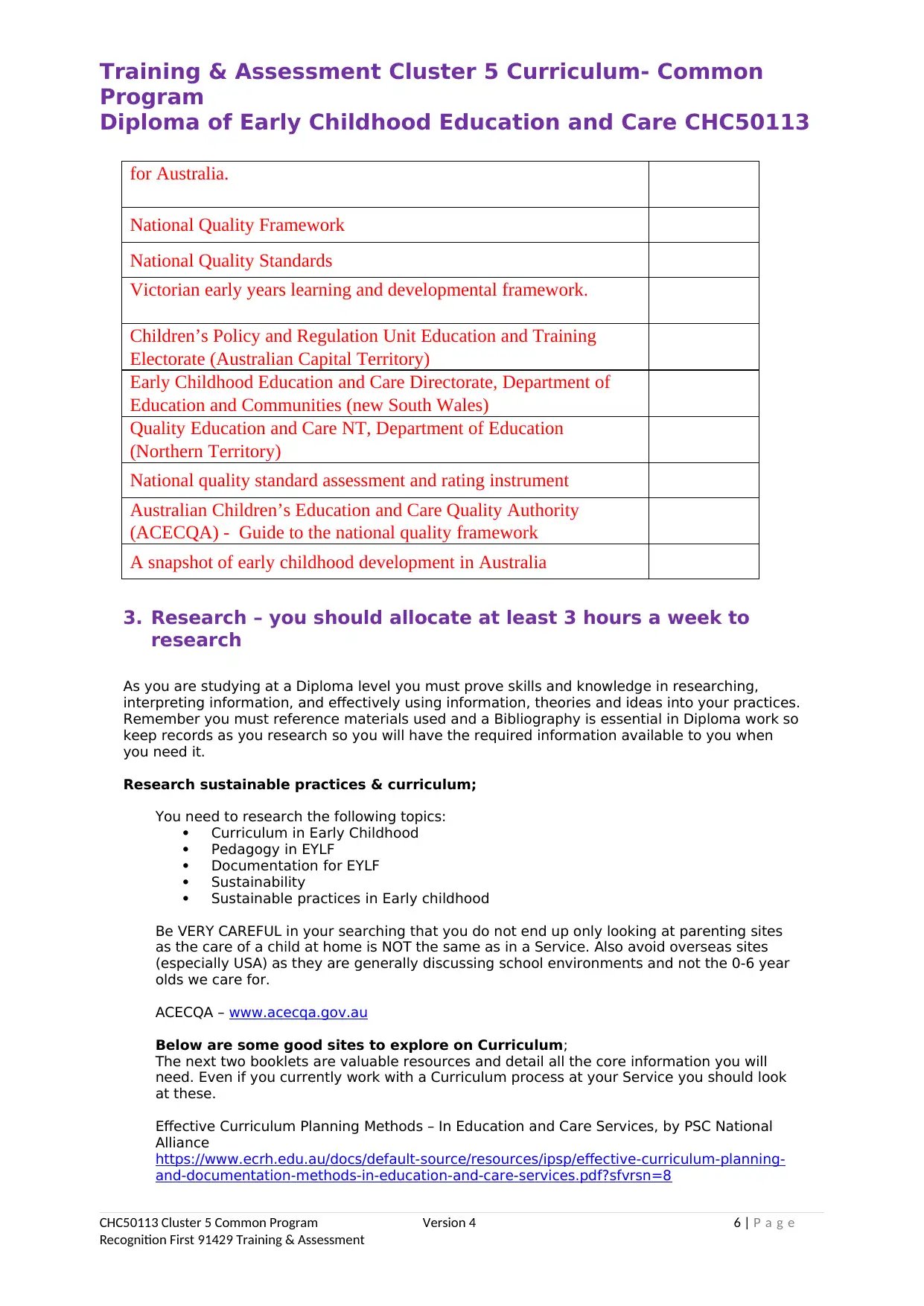
Training & Assessment Cluster 5 Curriculum- Common
Program
Diploma of Early Childhood Education and Care CHC50113
for Australia.
National Quality Framework
National Quality Standards
Victorian early years learning and developmental framework.
Children’s Policy and Regulation Unit Education and Training
Electorate (Australian Capital Territory)
Early Childhood Education and Care Directorate, Department of
Education and Communities (new South Wales)
Quality Education and Care NT, Department of Education
(Northern Territory)
National quality standard assessment and rating instrument
Australian Children’s Education and Care Quality Authority
(ACECQA) - Guide to the national quality framework
A snapshot of early childhood development in Australia
3. Research – you should allocate at least 3 hours a week to
research
As you are studying at a Diploma level you must prove skills and knowledge in researching,
interpreting information, and effectively using information, theories and ideas into your practices.
Remember you must reference materials used and a Bibliography is essential in Diploma work so
keep records as you research so you will have the required information available to you when
you need it.
Research sustainable practices & curriculum;
You need to research the following topics:
Curriculum in Early Childhood
Pedagogy in EYLF
Documentation for EYLF
Sustainability
Sustainable practices in Early childhood
Be VERY CAREFUL in your searching that you do not end up only looking at parenting sites
as the care of a child at home is NOT the same as in a Service. Also avoid overseas sites
(especially USA) as they are generally discussing school environments and not the 0-6 year
olds we care for.
ACECQA – www.acecqa.gov.au
Below are some good sites to explore on Curriculum;
The next two booklets are valuable resources and detail all the core information you will
need. Even if you currently work with a Curriculum process at your Service you should look
at these.
Effective Curriculum Planning Methods – In Education and Care Services, by PSC National
Alliance
https://www.ecrh.edu.au/docs/default-source/resources/ipsp/effective-curriculum-planning-
and-documentation-methods-in-education-and-care-services.pdf?sfvrsn=8
CHC50113 Cluster 5 Common Program Version 4 6 | P a g e
Recognition First 91429 Training & Assessment
Program
Diploma of Early Childhood Education and Care CHC50113
for Australia.
National Quality Framework
National Quality Standards
Victorian early years learning and developmental framework.
Children’s Policy and Regulation Unit Education and Training
Electorate (Australian Capital Territory)
Early Childhood Education and Care Directorate, Department of
Education and Communities (new South Wales)
Quality Education and Care NT, Department of Education
(Northern Territory)
National quality standard assessment and rating instrument
Australian Children’s Education and Care Quality Authority
(ACECQA) - Guide to the national quality framework
A snapshot of early childhood development in Australia
3. Research – you should allocate at least 3 hours a week to
research
As you are studying at a Diploma level you must prove skills and knowledge in researching,
interpreting information, and effectively using information, theories and ideas into your practices.
Remember you must reference materials used and a Bibliography is essential in Diploma work so
keep records as you research so you will have the required information available to you when
you need it.
Research sustainable practices & curriculum;
You need to research the following topics:
Curriculum in Early Childhood
Pedagogy in EYLF
Documentation for EYLF
Sustainability
Sustainable practices in Early childhood
Be VERY CAREFUL in your searching that you do not end up only looking at parenting sites
as the care of a child at home is NOT the same as in a Service. Also avoid overseas sites
(especially USA) as they are generally discussing school environments and not the 0-6 year
olds we care for.
ACECQA – www.acecqa.gov.au
Below are some good sites to explore on Curriculum;
The next two booklets are valuable resources and detail all the core information you will
need. Even if you currently work with a Curriculum process at your Service you should look
at these.
Effective Curriculum Planning Methods – In Education and Care Services, by PSC National
Alliance
https://www.ecrh.edu.au/docs/default-source/resources/ipsp/effective-curriculum-planning-
and-documentation-methods-in-education-and-care-services.pdf?sfvrsn=8
CHC50113 Cluster 5 Common Program Version 4 6 | P a g e
Recognition First 91429 Training & Assessment
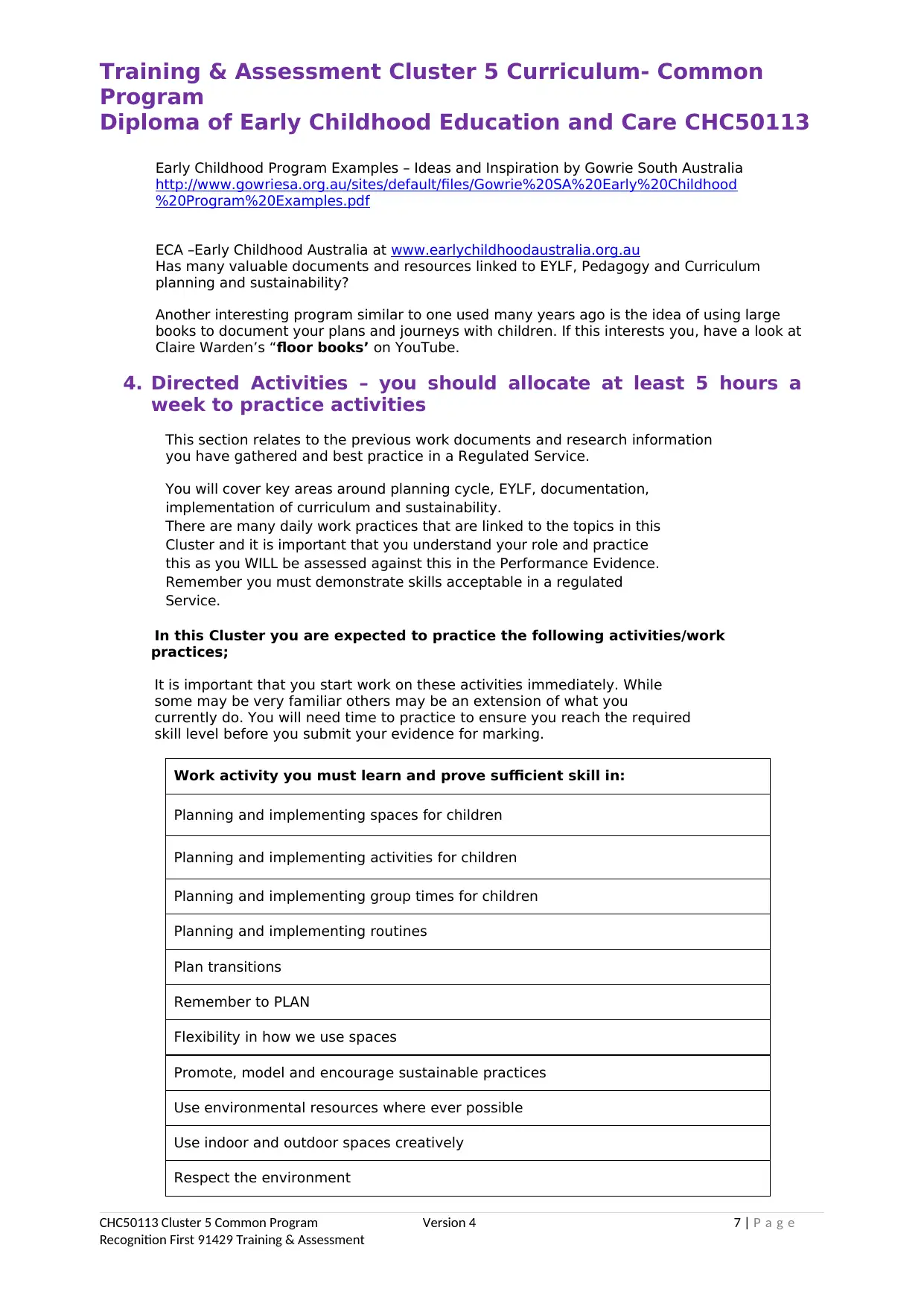
Training & Assessment Cluster 5 Curriculum- Common
Program
Diploma of Early Childhood Education and Care CHC50113
Early Childhood Program Examples – Ideas and Inspiration by Gowrie South Australia
http://www.gowriesa.org.au/sites/default/files/Gowrie%20SA%20Early%20Childhood
%20Program%20Examples.pdf
ECA –Early Childhood Australia at www.earlychildhoodaustralia.org.au
Has many valuable documents and resources linked to EYLF, Pedagogy and Curriculum
planning and sustainability?
Another interesting program similar to one used many years ago is the idea of using large
books to document your plans and journeys with children. If this interests you, have a look at
Claire Warden’s “floor books’ on YouTube.
4. Directed Activities – you should allocate at least 5 hours a
week to practice activities
This section relates to the previous work documents and research information
you have gathered and best practice in a Regulated Service.
You will cover key areas around planning cycle, EYLF, documentation,
implementation of curriculum and sustainability.
There are many daily work practices that are linked to the topics in this
Cluster and it is important that you understand your role and practice
this as you WILL be assessed against this in the Performance Evidence.
Remember you must demonstrate skills acceptable in a regulated
Service.
In this Cluster you are expected to practice the following activities/work
practices;
It is important that you start work on these activities immediately. While
some may be very familiar others may be an extension of what you
currently do. You will need time to practice to ensure you reach the required
skill level before you submit your evidence for marking.
Work activity you must learn and prove sufficient skill in:
Planning and implementing spaces for children
Planning and implementing activities for children
Planning and implementing group times for children
Planning and implementing routines
Plan transitions
Remember to PLAN
Flexibility in how we use spaces
Promote, model and encourage sustainable practices
Use environmental resources where ever possible
Use indoor and outdoor spaces creatively
Respect the environment
CHC50113 Cluster 5 Common Program Version 4 7 | P a g e
Recognition First 91429 Training & Assessment
Program
Diploma of Early Childhood Education and Care CHC50113
Early Childhood Program Examples – Ideas and Inspiration by Gowrie South Australia
http://www.gowriesa.org.au/sites/default/files/Gowrie%20SA%20Early%20Childhood
%20Program%20Examples.pdf
ECA –Early Childhood Australia at www.earlychildhoodaustralia.org.au
Has many valuable documents and resources linked to EYLF, Pedagogy and Curriculum
planning and sustainability?
Another interesting program similar to one used many years ago is the idea of using large
books to document your plans and journeys with children. If this interests you, have a look at
Claire Warden’s “floor books’ on YouTube.
4. Directed Activities – you should allocate at least 5 hours a
week to practice activities
This section relates to the previous work documents and research information
you have gathered and best practice in a Regulated Service.
You will cover key areas around planning cycle, EYLF, documentation,
implementation of curriculum and sustainability.
There are many daily work practices that are linked to the topics in this
Cluster and it is important that you understand your role and practice
this as you WILL be assessed against this in the Performance Evidence.
Remember you must demonstrate skills acceptable in a regulated
Service.
In this Cluster you are expected to practice the following activities/work
practices;
It is important that you start work on these activities immediately. While
some may be very familiar others may be an extension of what you
currently do. You will need time to practice to ensure you reach the required
skill level before you submit your evidence for marking.
Work activity you must learn and prove sufficient skill in:
Planning and implementing spaces for children
Planning and implementing activities for children
Planning and implementing group times for children
Planning and implementing routines
Plan transitions
Remember to PLAN
Flexibility in how we use spaces
Promote, model and encourage sustainable practices
Use environmental resources where ever possible
Use indoor and outdoor spaces creatively
Respect the environment
CHC50113 Cluster 5 Common Program Version 4 7 | P a g e
Recognition First 91429 Training & Assessment
Paraphrase This Document
Need a fresh take? Get an instant paraphrase of this document with our AI Paraphraser
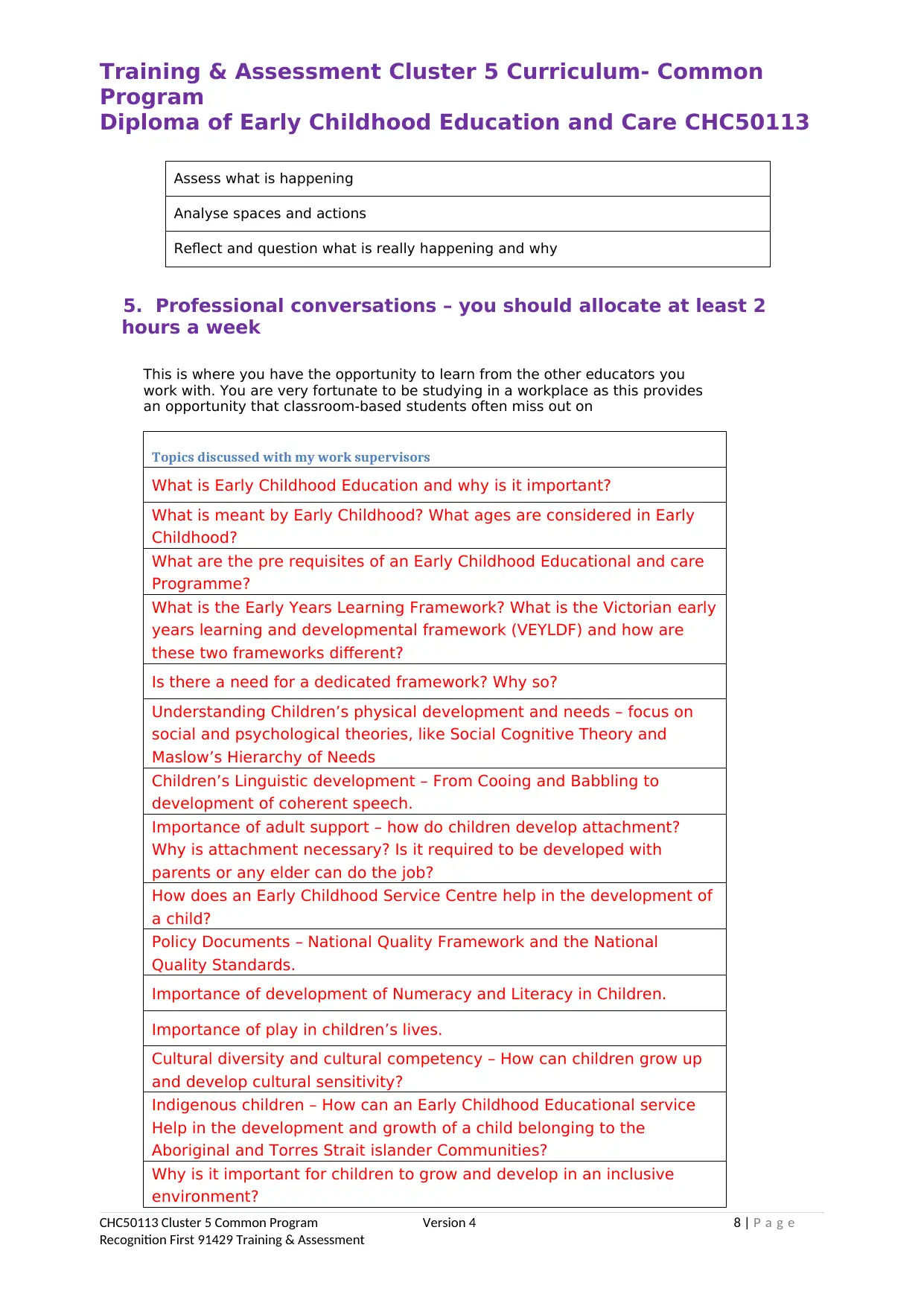
Training & Assessment Cluster 5 Curriculum- Common
Program
Diploma of Early Childhood Education and Care CHC50113
Assess what is happening
Analyse spaces and actions
Reflect and question what is really happening and why
5. Professional conversations – you should allocate at least 2
hours a week
This is where you have the opportunity to learn from the other educators you
work with. You are very fortunate to be studying in a workplace as this provides
an opportunity that classroom-based students often miss out on
Topics discussed with my work supervisors
What is Early Childhood Education and why is it important?
What is meant by Early Childhood? What ages are considered in Early
Childhood?
What are the pre requisites of an Early Childhood Educational and care
Programme?
What is the Early Years Learning Framework? What is the Victorian early
years learning and developmental framework (VEYLDF) and how are
these two frameworks different?
Is there a need for a dedicated framework? Why so?
Understanding Children’s physical development and needs – focus on
social and psychological theories, like Social Cognitive Theory and
Maslow’s Hierarchy of Needs
Children’s Linguistic development – From Cooing and Babbling to
development of coherent speech.
Importance of adult support – how do children develop attachment?
Why is attachment necessary? Is it required to be developed with
parents or any elder can do the job?
How does an Early Childhood Service Centre help in the development of
a child?
Policy Documents – National Quality Framework and the National
Quality Standards.
Importance of development of Numeracy and Literacy in Children.
Importance of play in children’s lives.
Cultural diversity and cultural competency – How can children grow up
and develop cultural sensitivity?
Indigenous children – How can an Early Childhood Educational service
Help in the development and growth of a child belonging to the
Aboriginal and Torres Strait islander Communities?
Why is it important for children to grow and develop in an inclusive
environment?
CHC50113 Cluster 5 Common Program Version 4 8 | P a g e
Recognition First 91429 Training & Assessment
Program
Diploma of Early Childhood Education and Care CHC50113
Assess what is happening
Analyse spaces and actions
Reflect and question what is really happening and why
5. Professional conversations – you should allocate at least 2
hours a week
This is where you have the opportunity to learn from the other educators you
work with. You are very fortunate to be studying in a workplace as this provides
an opportunity that classroom-based students often miss out on
Topics discussed with my work supervisors
What is Early Childhood Education and why is it important?
What is meant by Early Childhood? What ages are considered in Early
Childhood?
What are the pre requisites of an Early Childhood Educational and care
Programme?
What is the Early Years Learning Framework? What is the Victorian early
years learning and developmental framework (VEYLDF) and how are
these two frameworks different?
Is there a need for a dedicated framework? Why so?
Understanding Children’s physical development and needs – focus on
social and psychological theories, like Social Cognitive Theory and
Maslow’s Hierarchy of Needs
Children’s Linguistic development – From Cooing and Babbling to
development of coherent speech.
Importance of adult support – how do children develop attachment?
Why is attachment necessary? Is it required to be developed with
parents or any elder can do the job?
How does an Early Childhood Service Centre help in the development of
a child?
Policy Documents – National Quality Framework and the National
Quality Standards.
Importance of development of Numeracy and Literacy in Children.
Importance of play in children’s lives.
Cultural diversity and cultural competency – How can children grow up
and develop cultural sensitivity?
Indigenous children – How can an Early Childhood Educational service
Help in the development and growth of a child belonging to the
Aboriginal and Torres Strait islander Communities?
Why is it important for children to grow and develop in an inclusive
environment?
CHC50113 Cluster 5 Common Program Version 4 8 | P a g e
Recognition First 91429 Training & Assessment
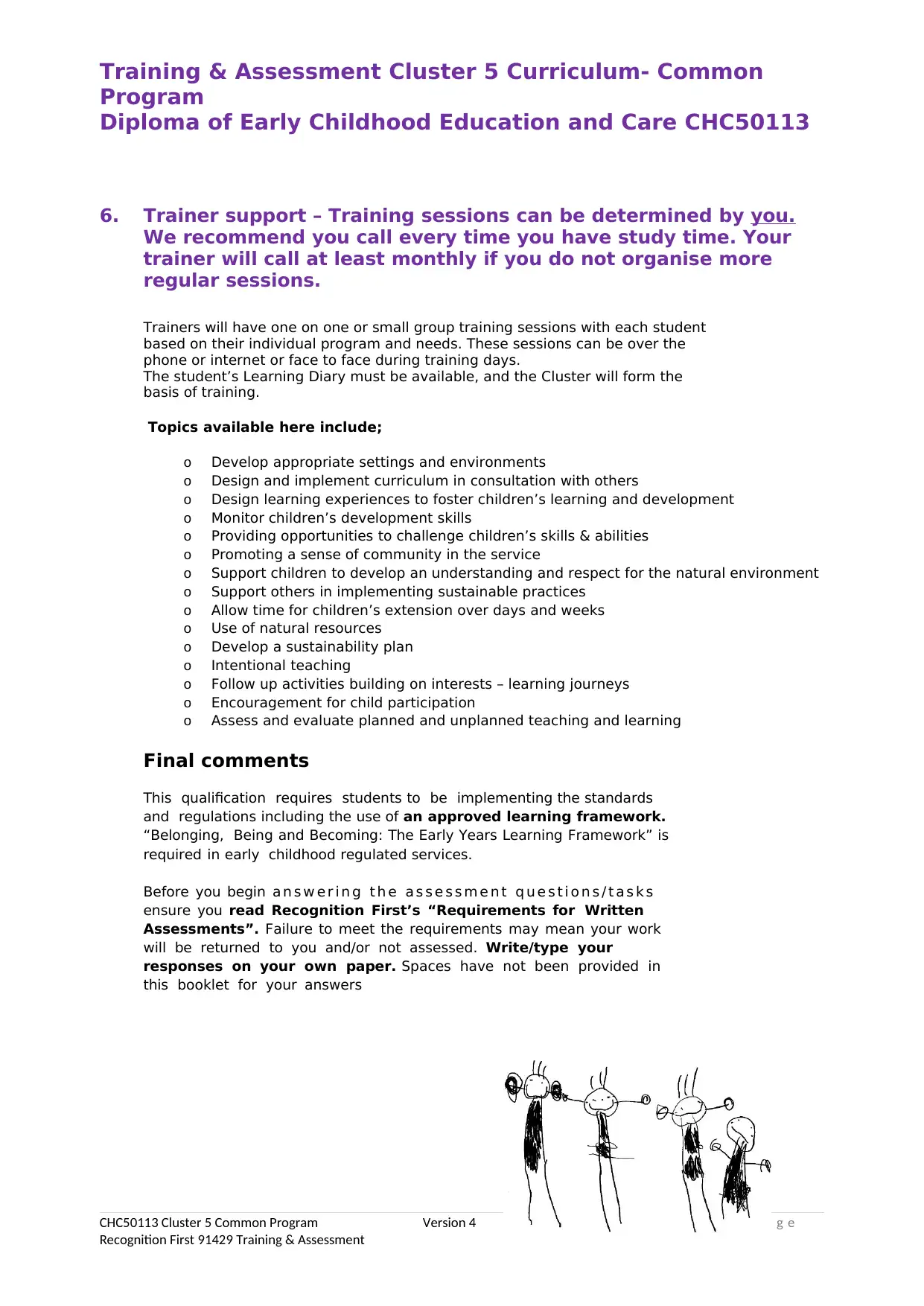
Training & Assessment Cluster 5 Curriculum- Common
Program
Diploma of Early Childhood Education and Care CHC50113
6. Trainer support – Training sessions can be determined by you.
We recommend you call every time you have study time. Your
trainer will call at least monthly if you do not organise more
regular sessions.
Trainers will have one on one or small group training sessions with each student
based on their individual program and needs. These sessions can be over the
phone or internet or face to face during training days.
The student’s Learning Diary must be available, and the Cluster will form the
basis of training.
Topics available here include;
o Develop appropriate settings and environments
o Design and implement curriculum in consultation with others
o Design learning experiences to foster children’s learning and development
o Monitor children’s development skills
o Providing opportunities to challenge children’s skills & abilities
o Promoting a sense of community in the service
o Support children to develop an understanding and respect for the natural environment
o Support others in implementing sustainable practices
o Allow time for children’s extension over days and weeks
o Use of natural resources
o Develop a sustainability plan
o Intentional teaching
o Follow up activities building on interests – learning journeys
o Encouragement for child participation
o Assess and evaluate planned and unplanned teaching and learning
Final comments
This qualification requires students to be implementing the standards
and regulations including the use of an approved learning framework.
“Belonging, Being and Becoming: The Early Years Learning Framework” is
required in early childhood regulated services.
Before you begin a n s w e r i n g t h e a s s e s s m e n t q u e s t i o n s / t a s k s
ensure you read Recognition First’s “Requirements for Written
Assessments”. Failure to meet the requirements may mean your work
will be returned to you and/or not assessed. Write/type your
responses on your own paper. Spaces have not been provided in
this booklet for your answers
CHC50113 Cluster 5 Common Program Version 4 9 | P a g e
Recognition First 91429 Training & Assessment
Program
Diploma of Early Childhood Education and Care CHC50113
6. Trainer support – Training sessions can be determined by you.
We recommend you call every time you have study time. Your
trainer will call at least monthly if you do not organise more
regular sessions.
Trainers will have one on one or small group training sessions with each student
based on their individual program and needs. These sessions can be over the
phone or internet or face to face during training days.
The student’s Learning Diary must be available, and the Cluster will form the
basis of training.
Topics available here include;
o Develop appropriate settings and environments
o Design and implement curriculum in consultation with others
o Design learning experiences to foster children’s learning and development
o Monitor children’s development skills
o Providing opportunities to challenge children’s skills & abilities
o Promoting a sense of community in the service
o Support children to develop an understanding and respect for the natural environment
o Support others in implementing sustainable practices
o Allow time for children’s extension over days and weeks
o Use of natural resources
o Develop a sustainability plan
o Intentional teaching
o Follow up activities building on interests – learning journeys
o Encouragement for child participation
o Assess and evaluate planned and unplanned teaching and learning
Final comments
This qualification requires students to be implementing the standards
and regulations including the use of an approved learning framework.
“Belonging, Being and Becoming: The Early Years Learning Framework” is
required in early childhood regulated services.
Before you begin a n s w e r i n g t h e a s s e s s m e n t q u e s t i o n s / t a s k s
ensure you read Recognition First’s “Requirements for Written
Assessments”. Failure to meet the requirements may mean your work
will be returned to you and/or not assessed. Write/type your
responses on your own paper. Spaces have not been provided in
this booklet for your answers
CHC50113 Cluster 5 Common Program Version 4 9 | P a g e
Recognition First 91429 Training & Assessment
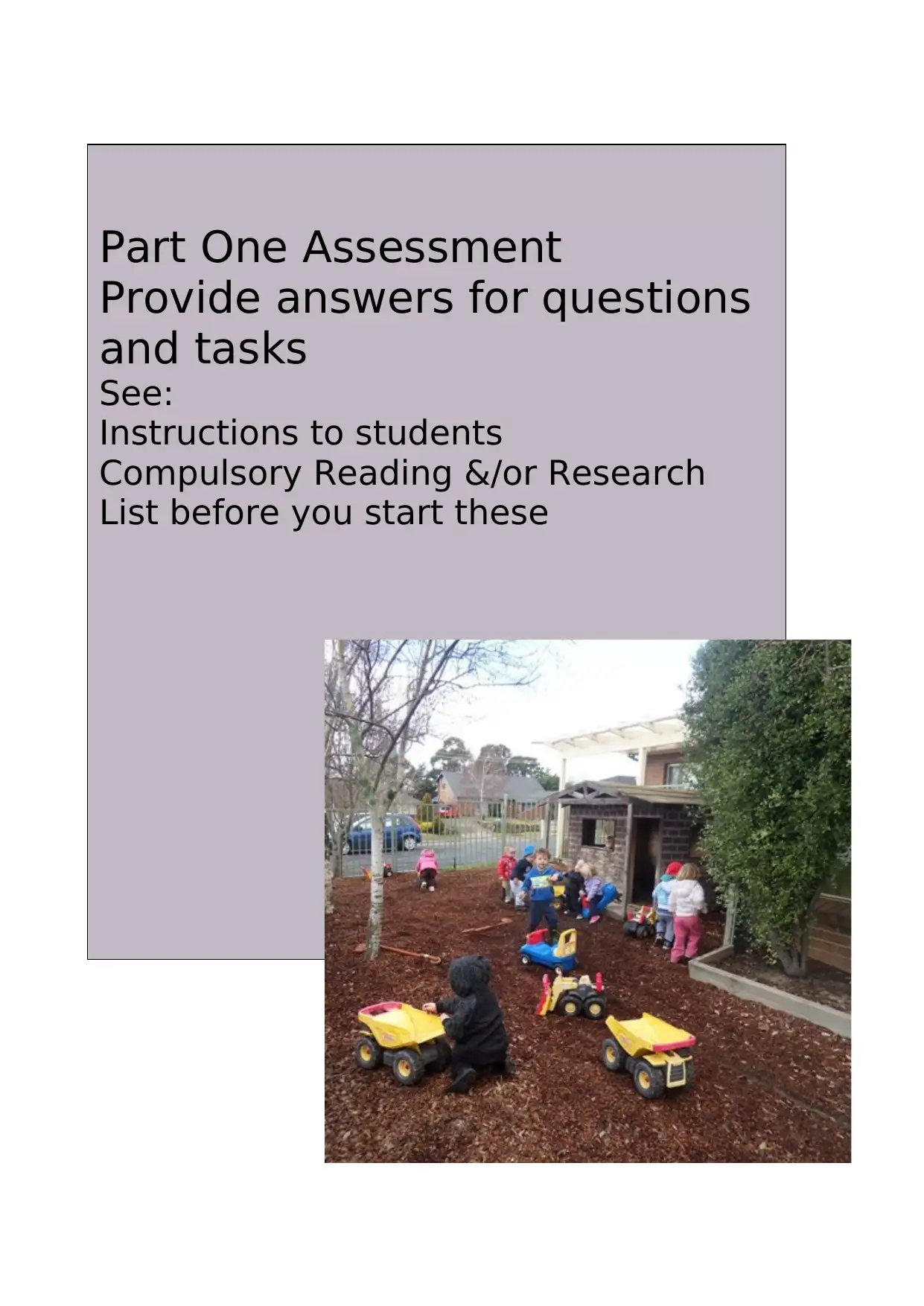
Part One Assessment
Provide answers for questions
and tasks
See:
Instructions to students
Compulsory Reading &/or Research
List before you start these
Provide answers for questions
and tasks
See:
Instructions to students
Compulsory Reading &/or Research
List before you start these
Secure Best Marks with AI Grader
Need help grading? Try our AI Grader for instant feedback on your assignments.
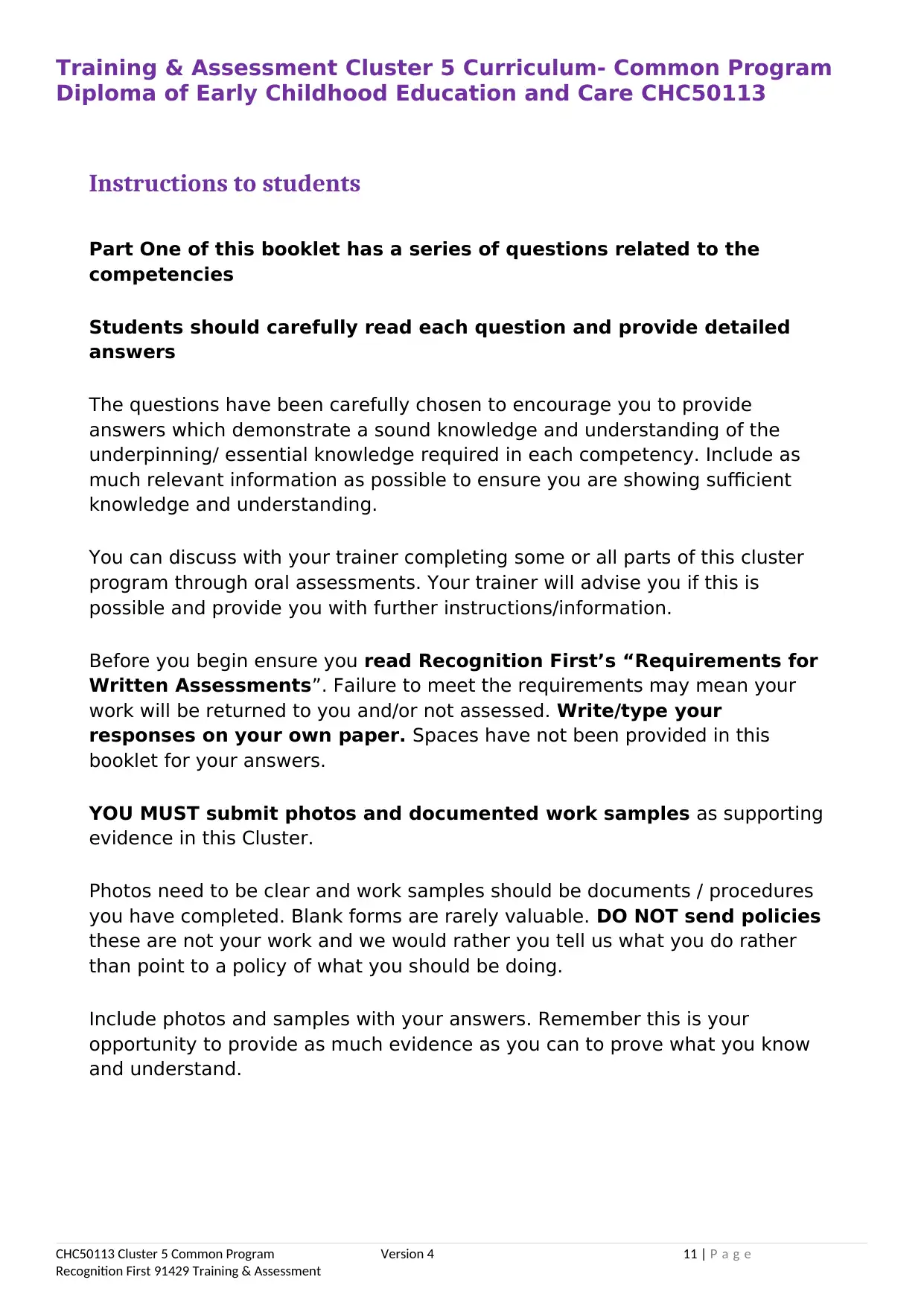
Training & Assessment Cluster 5 Curriculum- Common Program
Diploma of Early Childhood Education and Care CHC50113
Instructions to students
Part One of this booklet has a series of questions related to the
competencies
Students should carefully read each question and provide detailed
answers
The questions have been carefully chosen to encourage you to provide
answers which demonstrate a sound knowledge and understanding of the
underpinning/ essential knowledge required in each competency. Include as
much relevant information as possible to ensure you are showing sufficient
knowledge and understanding.
You can discuss with your trainer completing some or all parts of this cluster
program through oral assessments. Your trainer will advise you if this is
possible and provide you with further instructions/information.
Before you begin ensure you read Recognition First’s “Requirements for
Written Assessments”. Failure to meet the requirements may mean your
work will be returned to you and/or not assessed. Write/type your
responses on your own paper. Spaces have not been provided in this
booklet for your answers.
YOU MUST submit photos and documented work samples as supporting
evidence in this Cluster.
Photos need to be clear and work samples should be documents / procedures
you have completed. Blank forms are rarely valuable. DO NOT send policies
these are not your work and we would rather you tell us what you do rather
than point to a policy of what you should be doing.
Include photos and samples with your answers. Remember this is your
opportunity to provide as much evidence as you can to prove what you know
and understand.
CHC50113 Cluster 5 Common Program Version 4 11 | P a g e
Recognition First 91429 Training & Assessment
Diploma of Early Childhood Education and Care CHC50113
Instructions to students
Part One of this booklet has a series of questions related to the
competencies
Students should carefully read each question and provide detailed
answers
The questions have been carefully chosen to encourage you to provide
answers which demonstrate a sound knowledge and understanding of the
underpinning/ essential knowledge required in each competency. Include as
much relevant information as possible to ensure you are showing sufficient
knowledge and understanding.
You can discuss with your trainer completing some or all parts of this cluster
program through oral assessments. Your trainer will advise you if this is
possible and provide you with further instructions/information.
Before you begin ensure you read Recognition First’s “Requirements for
Written Assessments”. Failure to meet the requirements may mean your
work will be returned to you and/or not assessed. Write/type your
responses on your own paper. Spaces have not been provided in this
booklet for your answers.
YOU MUST submit photos and documented work samples as supporting
evidence in this Cluster.
Photos need to be clear and work samples should be documents / procedures
you have completed. Blank forms are rarely valuable. DO NOT send policies
these are not your work and we would rather you tell us what you do rather
than point to a policy of what you should be doing.
Include photos and samples with your answers. Remember this is your
opportunity to provide as much evidence as you can to prove what you know
and understand.
CHC50113 Cluster 5 Common Program Version 4 11 | P a g e
Recognition First 91429 Training & Assessment
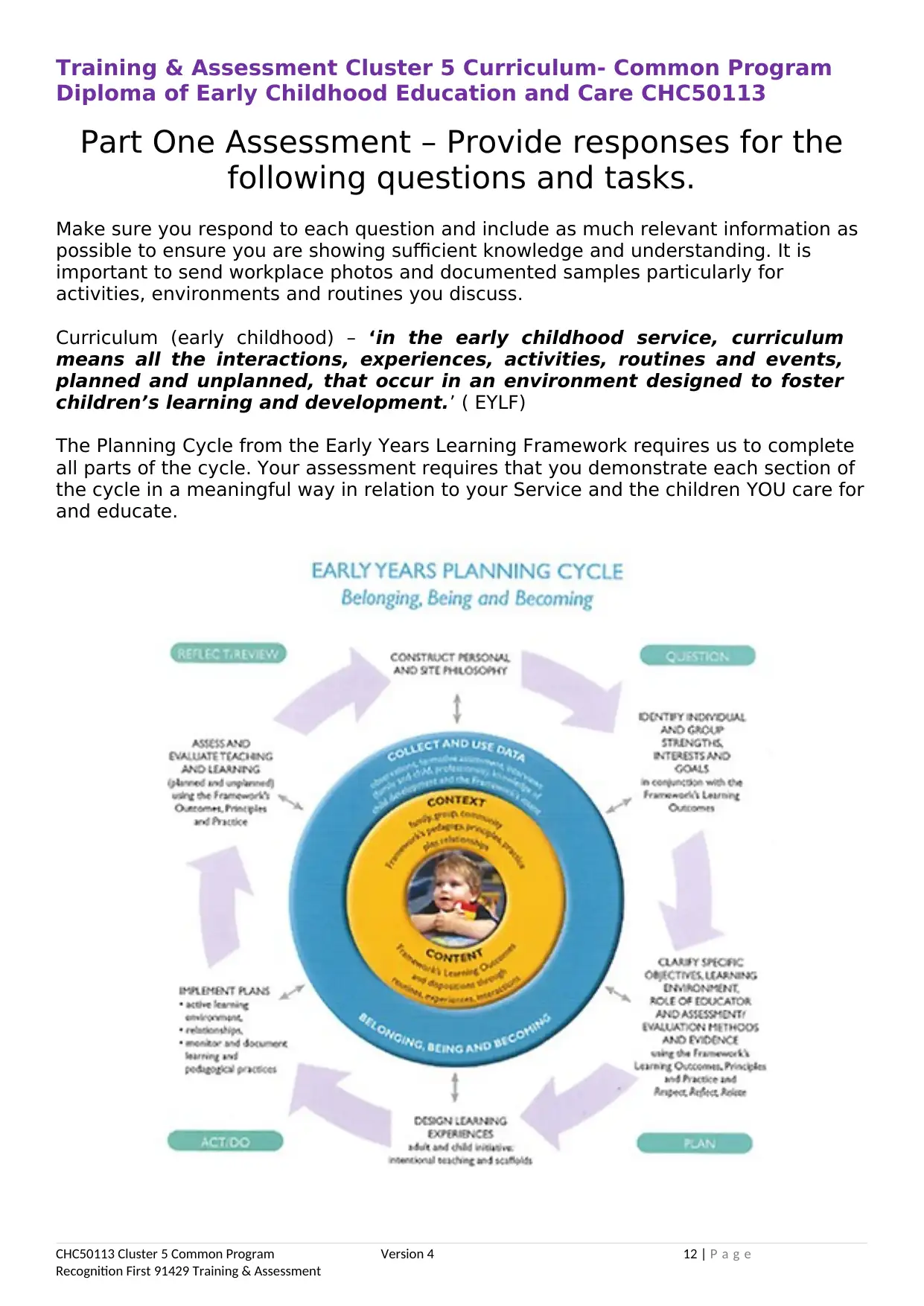
Training & Assessment Cluster 5 Curriculum- Common Program
Diploma of Early Childhood Education and Care CHC50113
Part One Assessment – Provide responses for the
following questions and tasks.
Make sure you respond to each question and include as much relevant information as
possible to ensure you are showing sufficient knowledge and understanding. It is
important to send workplace photos and documented samples particularly for
activities, environments and routines you discuss.
Curriculum (early childhood) – ‘in the early childhood service, curriculum
means all the interactions, experiences, activities, routines and events,
planned and unplanned, that occur in an environment designed to foster
children’s learning and development.’ ( EYLF)
The Planning Cycle from the Early Years Learning Framework requires us to complete
all parts of the cycle. Your assessment requires that you demonstrate each section of
the cycle in a meaningful way in relation to your Service and the children YOU care for
and educate.
CHC50113 Cluster 5 Common Program Version 4 12 | P a g e
Recognition First 91429 Training & Assessment
Diploma of Early Childhood Education and Care CHC50113
Part One Assessment – Provide responses for the
following questions and tasks.
Make sure you respond to each question and include as much relevant information as
possible to ensure you are showing sufficient knowledge and understanding. It is
important to send workplace photos and documented samples particularly for
activities, environments and routines you discuss.
Curriculum (early childhood) – ‘in the early childhood service, curriculum
means all the interactions, experiences, activities, routines and events,
planned and unplanned, that occur in an environment designed to foster
children’s learning and development.’ ( EYLF)
The Planning Cycle from the Early Years Learning Framework requires us to complete
all parts of the cycle. Your assessment requires that you demonstrate each section of
the cycle in a meaningful way in relation to your Service and the children YOU care for
and educate.
CHC50113 Cluster 5 Common Program Version 4 12 | P a g e
Recognition First 91429 Training & Assessment
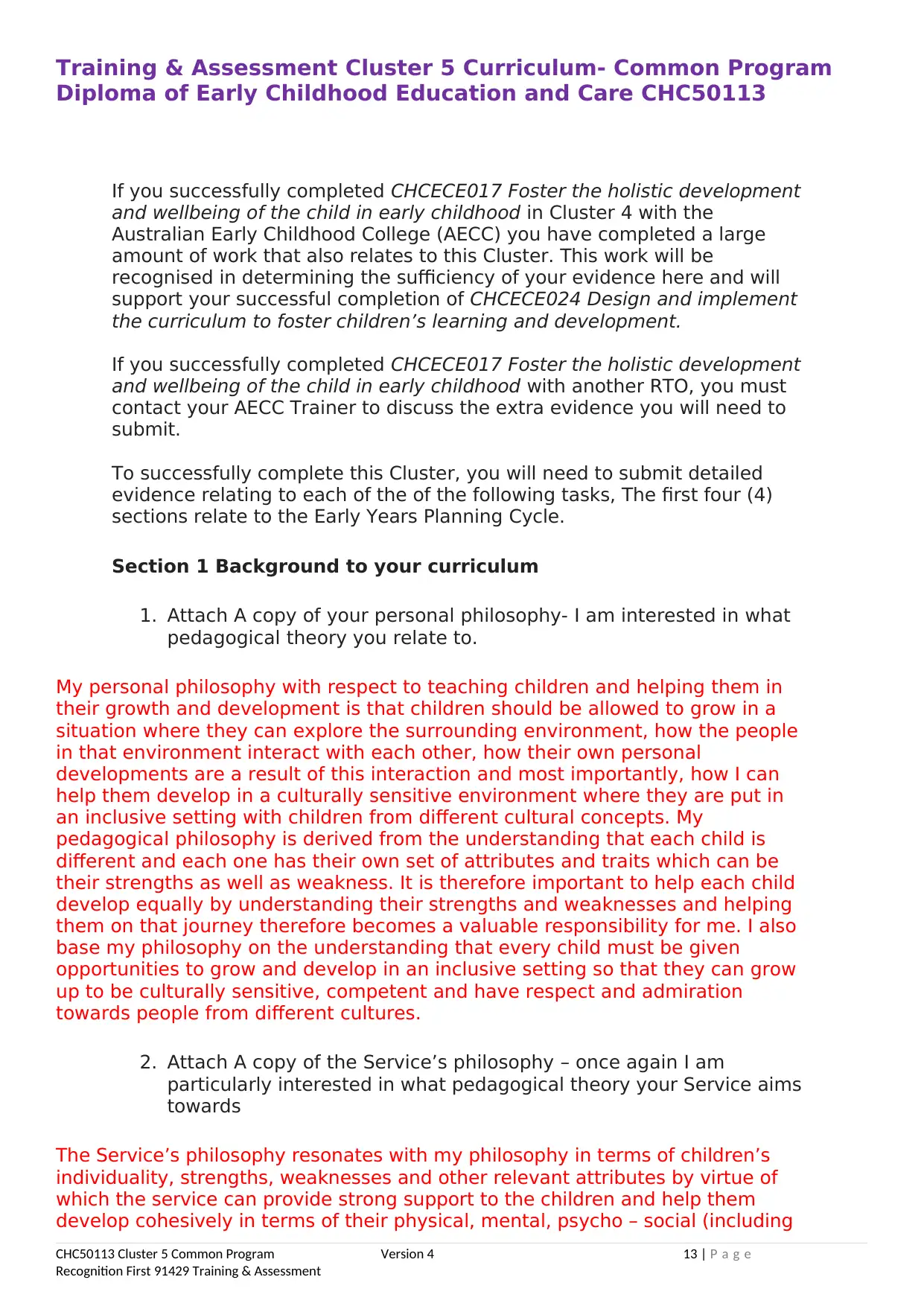
Training & Assessment Cluster 5 Curriculum- Common Program
Diploma of Early Childhood Education and Care CHC50113
If you successfully completed CHCECE017 Foster the holistic development
and wellbeing of the child in early childhood in Cluster 4 with the
Australian Early Childhood College (AECC) you have completed a large
amount of work that also relates to this Cluster. This work will be
recognised in determining the sufficiency of your evidence here and will
support your successful completion of CHCECE024 Design and implement
the curriculum to foster children’s learning and development.
If you successfully completed CHCECE017 Foster the holistic development
and wellbeing of the child in early childhood with another RTO, you must
contact your AECC Trainer to discuss the extra evidence you will need to
submit.
To successfully complete this Cluster, you will need to submit detailed
evidence relating to each of the of the following tasks, The first four (4)
sections relate to the Early Years Planning Cycle.
Section 1 Background to your curriculum
1. Attach A copy of your personal philosophy- I am interested in what
pedagogical theory you relate to.
My personal philosophy with respect to teaching children and helping them in
their growth and development is that children should be allowed to grow in a
situation where they can explore the surrounding environment, how the people
in that environment interact with each other, how their own personal
developments are a result of this interaction and most importantly, how I can
help them develop in a culturally sensitive environment where they are put in
an inclusive setting with children from different cultural concepts. My
pedagogical philosophy is derived from the understanding that each child is
different and each one has their own set of attributes and traits which can be
their strengths as well as weakness. It is therefore important to help each child
develop equally by understanding their strengths and weaknesses and helping
them on that journey therefore becomes a valuable responsibility for me. I also
base my philosophy on the understanding that every child must be given
opportunities to grow and develop in an inclusive setting so that they can grow
up to be culturally sensitive, competent and have respect and admiration
towards people from different cultures.
2. Attach A copy of the Service’s philosophy – once again I am
particularly interested in what pedagogical theory your Service aims
towards
The Service’s philosophy resonates with my philosophy in terms of children’s
individuality, strengths, weaknesses and other relevant attributes by virtue of
which the service can provide strong support to the children and help them
develop cohesively in terms of their physical, mental, psycho – social (including
CHC50113 Cluster 5 Common Program Version 4 13 | P a g e
Recognition First 91429 Training & Assessment
Diploma of Early Childhood Education and Care CHC50113
If you successfully completed CHCECE017 Foster the holistic development
and wellbeing of the child in early childhood in Cluster 4 with the
Australian Early Childhood College (AECC) you have completed a large
amount of work that also relates to this Cluster. This work will be
recognised in determining the sufficiency of your evidence here and will
support your successful completion of CHCECE024 Design and implement
the curriculum to foster children’s learning and development.
If you successfully completed CHCECE017 Foster the holistic development
and wellbeing of the child in early childhood with another RTO, you must
contact your AECC Trainer to discuss the extra evidence you will need to
submit.
To successfully complete this Cluster, you will need to submit detailed
evidence relating to each of the of the following tasks, The first four (4)
sections relate to the Early Years Planning Cycle.
Section 1 Background to your curriculum
1. Attach A copy of your personal philosophy- I am interested in what
pedagogical theory you relate to.
My personal philosophy with respect to teaching children and helping them in
their growth and development is that children should be allowed to grow in a
situation where they can explore the surrounding environment, how the people
in that environment interact with each other, how their own personal
developments are a result of this interaction and most importantly, how I can
help them develop in a culturally sensitive environment where they are put in
an inclusive setting with children from different cultural concepts. My
pedagogical philosophy is derived from the understanding that each child is
different and each one has their own set of attributes and traits which can be
their strengths as well as weakness. It is therefore important to help each child
develop equally by understanding their strengths and weaknesses and helping
them on that journey therefore becomes a valuable responsibility for me. I also
base my philosophy on the understanding that every child must be given
opportunities to grow and develop in an inclusive setting so that they can grow
up to be culturally sensitive, competent and have respect and admiration
towards people from different cultures.
2. Attach A copy of the Service’s philosophy – once again I am
particularly interested in what pedagogical theory your Service aims
towards
The Service’s philosophy resonates with my philosophy in terms of children’s
individuality, strengths, weaknesses and other relevant attributes by virtue of
which the service can provide strong support to the children and help them
develop cohesively in terms of their physical, mental, psycho – social (including
CHC50113 Cluster 5 Common Program Version 4 13 | P a g e
Recognition First 91429 Training & Assessment
Paraphrase This Document
Need a fresh take? Get an instant paraphrase of this document with our AI Paraphraser
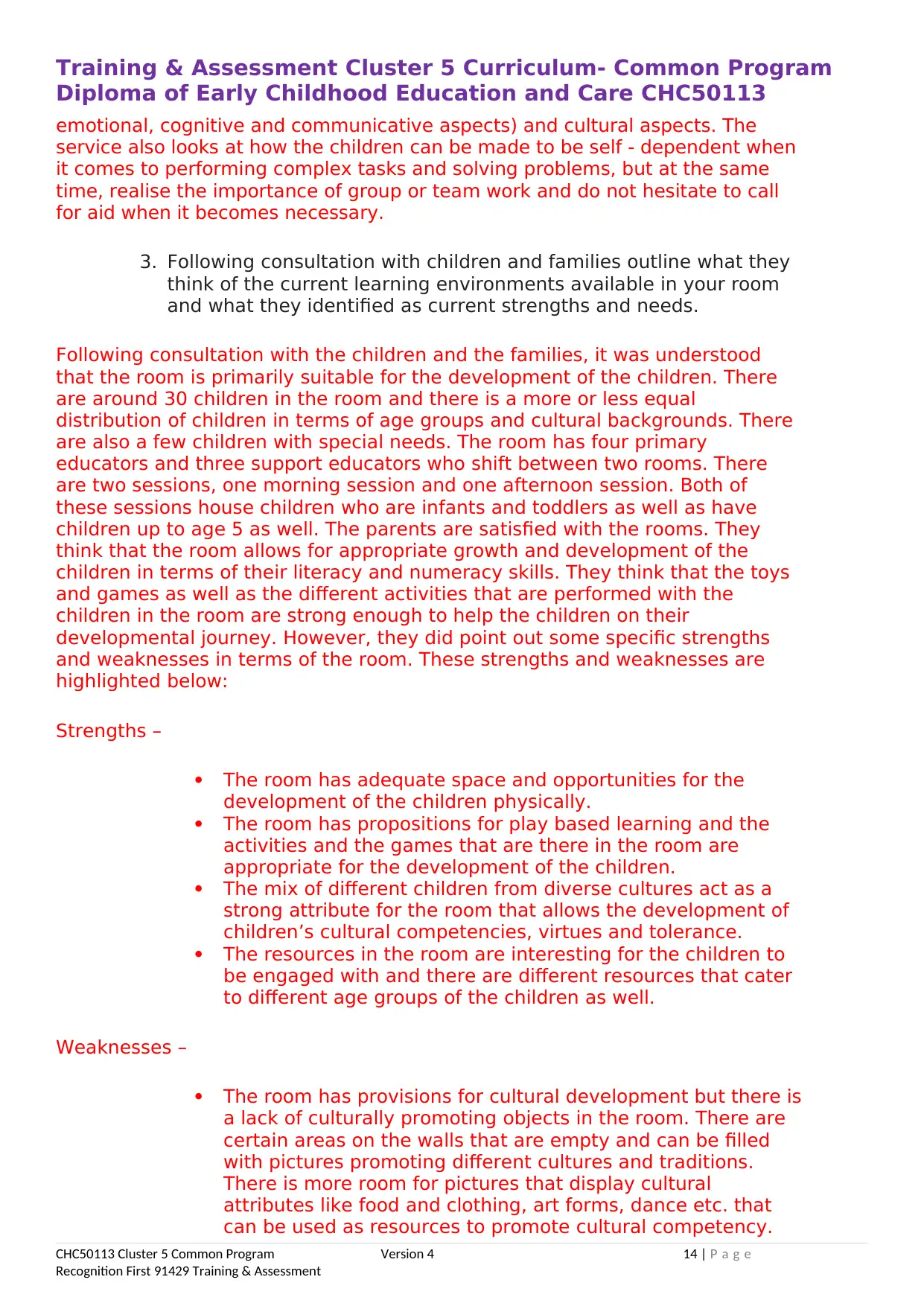
Training & Assessment Cluster 5 Curriculum- Common Program
Diploma of Early Childhood Education and Care CHC50113
emotional, cognitive and communicative aspects) and cultural aspects. The
service also looks at how the children can be made to be self - dependent when
it comes to performing complex tasks and solving problems, but at the same
time, realise the importance of group or team work and do not hesitate to call
for aid when it becomes necessary.
3. Following consultation with children and families outline what they
think of the current learning environments available in your room
and what they identified as current strengths and needs.
Following consultation with the children and the families, it was understood
that the room is primarily suitable for the development of the children. There
are around 30 children in the room and there is a more or less equal
distribution of children in terms of age groups and cultural backgrounds. There
are also a few children with special needs. The room has four primary
educators and three support educators who shift between two rooms. There
are two sessions, one morning session and one afternoon session. Both of
these sessions house children who are infants and toddlers as well as have
children up to age 5 as well. The parents are satisfied with the rooms. They
think that the room allows for appropriate growth and development of the
children in terms of their literacy and numeracy skills. They think that the toys
and games as well as the different activities that are performed with the
children in the room are strong enough to help the children on their
developmental journey. However, they did point out some specific strengths
and weaknesses in terms of the room. These strengths and weaknesses are
highlighted below:
Strengths –
The room has adequate space and opportunities for the
development of the children physically.
The room has propositions for play based learning and the
activities and the games that are there in the room are
appropriate for the development of the children.
The mix of different children from diverse cultures act as a
strong attribute for the room that allows the development of
children’s cultural competencies, virtues and tolerance.
The resources in the room are interesting for the children to
be engaged with and there are different resources that cater
to different age groups of the children as well.
Weaknesses –
The room has provisions for cultural development but there is
a lack of culturally promoting objects in the room. There are
certain areas on the walls that are empty and can be filled
with pictures promoting different cultures and traditions.
There is more room for pictures that display cultural
attributes like food and clothing, art forms, dance etc. that
can be used as resources to promote cultural competency.
CHC50113 Cluster 5 Common Program Version 4 14 | P a g e
Recognition First 91429 Training & Assessment
Diploma of Early Childhood Education and Care CHC50113
emotional, cognitive and communicative aspects) and cultural aspects. The
service also looks at how the children can be made to be self - dependent when
it comes to performing complex tasks and solving problems, but at the same
time, realise the importance of group or team work and do not hesitate to call
for aid when it becomes necessary.
3. Following consultation with children and families outline what they
think of the current learning environments available in your room
and what they identified as current strengths and needs.
Following consultation with the children and the families, it was understood
that the room is primarily suitable for the development of the children. There
are around 30 children in the room and there is a more or less equal
distribution of children in terms of age groups and cultural backgrounds. There
are also a few children with special needs. The room has four primary
educators and three support educators who shift between two rooms. There
are two sessions, one morning session and one afternoon session. Both of
these sessions house children who are infants and toddlers as well as have
children up to age 5 as well. The parents are satisfied with the rooms. They
think that the room allows for appropriate growth and development of the
children in terms of their literacy and numeracy skills. They think that the toys
and games as well as the different activities that are performed with the
children in the room are strong enough to help the children on their
developmental journey. However, they did point out some specific strengths
and weaknesses in terms of the room. These strengths and weaknesses are
highlighted below:
Strengths –
The room has adequate space and opportunities for the
development of the children physically.
The room has propositions for play based learning and the
activities and the games that are there in the room are
appropriate for the development of the children.
The mix of different children from diverse cultures act as a
strong attribute for the room that allows the development of
children’s cultural competencies, virtues and tolerance.
The resources in the room are interesting for the children to
be engaged with and there are different resources that cater
to different age groups of the children as well.
Weaknesses –
The room has provisions for cultural development but there is
a lack of culturally promoting objects in the room. There are
certain areas on the walls that are empty and can be filled
with pictures promoting different cultures and traditions.
There is more room for pictures that display cultural
attributes like food and clothing, art forms, dance etc. that
can be used as resources to promote cultural competency.
CHC50113 Cluster 5 Common Program Version 4 14 | P a g e
Recognition First 91429 Training & Assessment
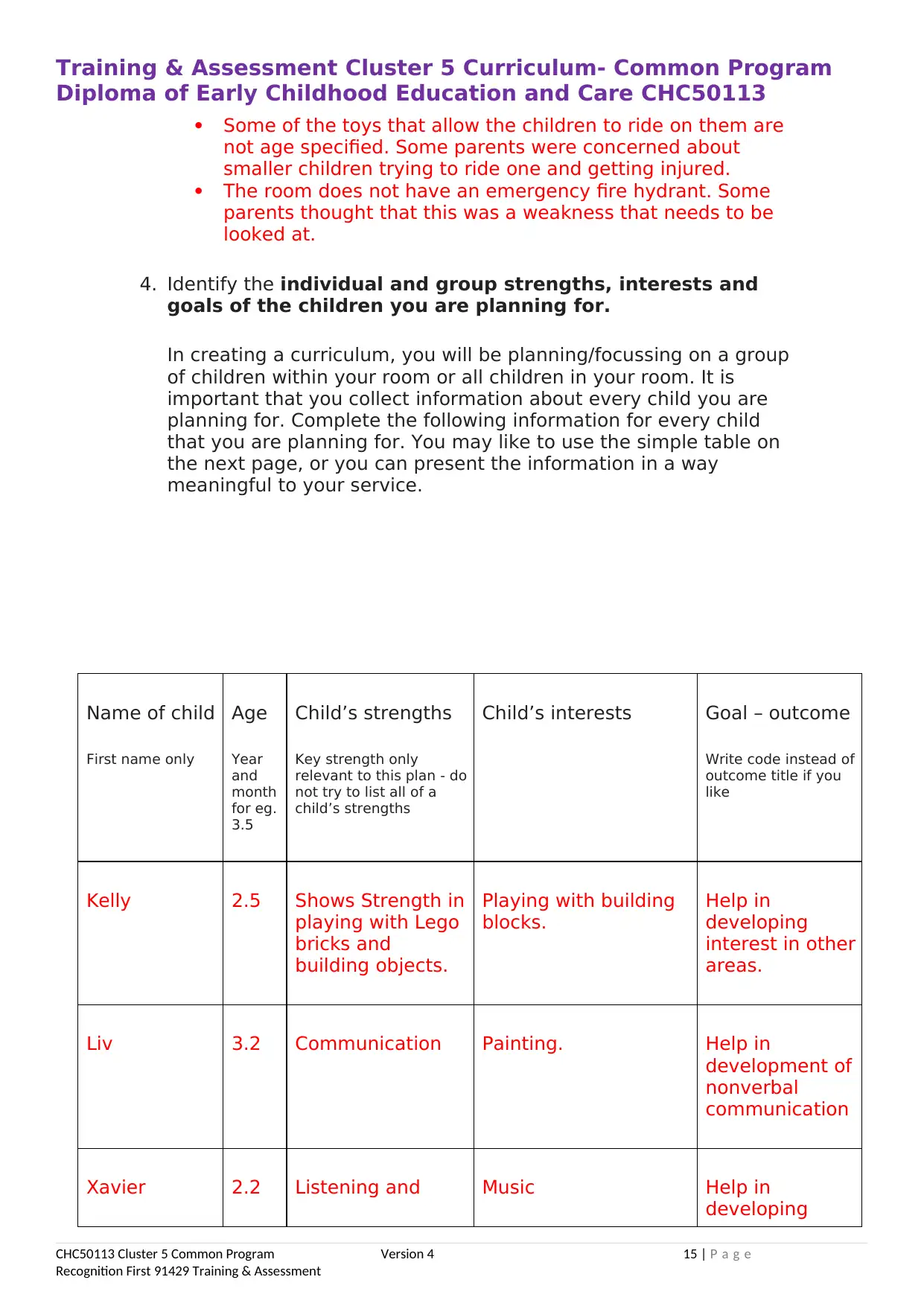
Training & Assessment Cluster 5 Curriculum- Common Program
Diploma of Early Childhood Education and Care CHC50113
Some of the toys that allow the children to ride on them are
not age specified. Some parents were concerned about
smaller children trying to ride one and getting injured.
The room does not have an emergency fire hydrant. Some
parents thought that this was a weakness that needs to be
looked at.
4. Identify the individual and group strengths, interests and
goals of the children you are planning for.
In creating a curriculum, you will be planning/focussing on a group
of children within your room or all children in your room. It is
important that you collect information about every child you are
planning for. Complete the following information for every child
that you are planning for. You may like to use the simple table on
the next page, or you can present the information in a way
meaningful to your service.
Name of child
First name only
Age
Year
and
month
for eg.
3.5
Child’s strengths
Key strength only
relevant to this plan - do
not try to list all of a
child’s strengths
Child’s interests Goal – outcome
Write code instead of
outcome title if you
like
Kelly 2.5 Shows Strength in
playing with Lego
bricks and
building objects.
Playing with building
blocks.
Help in
developing
interest in other
areas.
Liv 3.2 Communication Painting. Help in
development of
nonverbal
communication
Xavier 2.2 Listening and Music Help in
developing
CHC50113 Cluster 5 Common Program Version 4 15 | P a g e
Recognition First 91429 Training & Assessment
Diploma of Early Childhood Education and Care CHC50113
Some of the toys that allow the children to ride on them are
not age specified. Some parents were concerned about
smaller children trying to ride one and getting injured.
The room does not have an emergency fire hydrant. Some
parents thought that this was a weakness that needs to be
looked at.
4. Identify the individual and group strengths, interests and
goals of the children you are planning for.
In creating a curriculum, you will be planning/focussing on a group
of children within your room or all children in your room. It is
important that you collect information about every child you are
planning for. Complete the following information for every child
that you are planning for. You may like to use the simple table on
the next page, or you can present the information in a way
meaningful to your service.
Name of child
First name only
Age
Year
and
month
for eg.
3.5
Child’s strengths
Key strength only
relevant to this plan - do
not try to list all of a
child’s strengths
Child’s interests Goal – outcome
Write code instead of
outcome title if you
like
Kelly 2.5 Shows Strength in
playing with Lego
bricks and
building objects.
Playing with building
blocks.
Help in
developing
interest in other
areas.
Liv 3.2 Communication Painting. Help in
development of
nonverbal
communication
Xavier 2.2 Listening and Music Help in
developing
CHC50113 Cluster 5 Common Program Version 4 15 | P a g e
Recognition First 91429 Training & Assessment
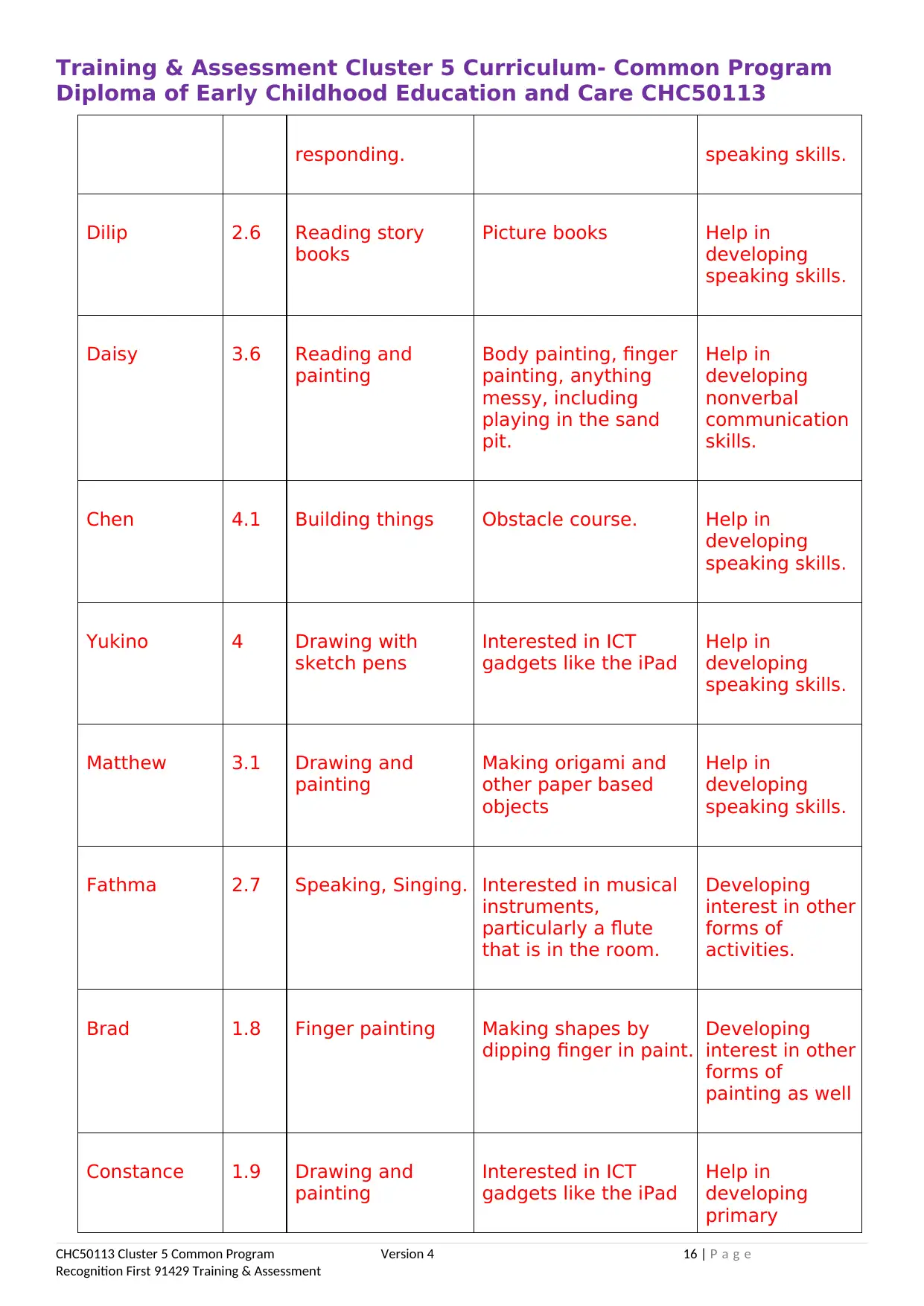
Training & Assessment Cluster 5 Curriculum- Common Program
Diploma of Early Childhood Education and Care CHC50113
responding. speaking skills.
Dilip 2.6 Reading story
books
Picture books Help in
developing
speaking skills.
Daisy 3.6 Reading and
painting
Body painting, finger
painting, anything
messy, including
playing in the sand
pit.
Help in
developing
nonverbal
communication
skills.
Chen 4.1 Building things Obstacle course. Help in
developing
speaking skills.
Yukino 4 Drawing with
sketch pens
Interested in ICT
gadgets like the iPad
Help in
developing
speaking skills.
Matthew 3.1 Drawing and
painting
Making origami and
other paper based
objects
Help in
developing
speaking skills.
Fathma 2.7 Speaking, Singing. Interested in musical
instruments,
particularly a flute
that is in the room.
Developing
interest in other
forms of
activities.
Brad 1.8 Finger painting Making shapes by
dipping finger in paint.
Developing
interest in other
forms of
painting as well
Constance 1.9 Drawing and
painting
Interested in ICT
gadgets like the iPad
Help in
developing
primary
CHC50113 Cluster 5 Common Program Version 4 16 | P a g e
Recognition First 91429 Training & Assessment
Diploma of Early Childhood Education and Care CHC50113
responding. speaking skills.
Dilip 2.6 Reading story
books
Picture books Help in
developing
speaking skills.
Daisy 3.6 Reading and
painting
Body painting, finger
painting, anything
messy, including
playing in the sand
pit.
Help in
developing
nonverbal
communication
skills.
Chen 4.1 Building things Obstacle course. Help in
developing
speaking skills.
Yukino 4 Drawing with
sketch pens
Interested in ICT
gadgets like the iPad
Help in
developing
speaking skills.
Matthew 3.1 Drawing and
painting
Making origami and
other paper based
objects
Help in
developing
speaking skills.
Fathma 2.7 Speaking, Singing. Interested in musical
instruments,
particularly a flute
that is in the room.
Developing
interest in other
forms of
activities.
Brad 1.8 Finger painting Making shapes by
dipping finger in paint.
Developing
interest in other
forms of
painting as well
Constance 1.9 Drawing and
painting
Interested in ICT
gadgets like the iPad
Help in
developing
primary
CHC50113 Cluster 5 Common Program Version 4 16 | P a g e
Recognition First 91429 Training & Assessment
Secure Best Marks with AI Grader
Need help grading? Try our AI Grader for instant feedback on your assignments.
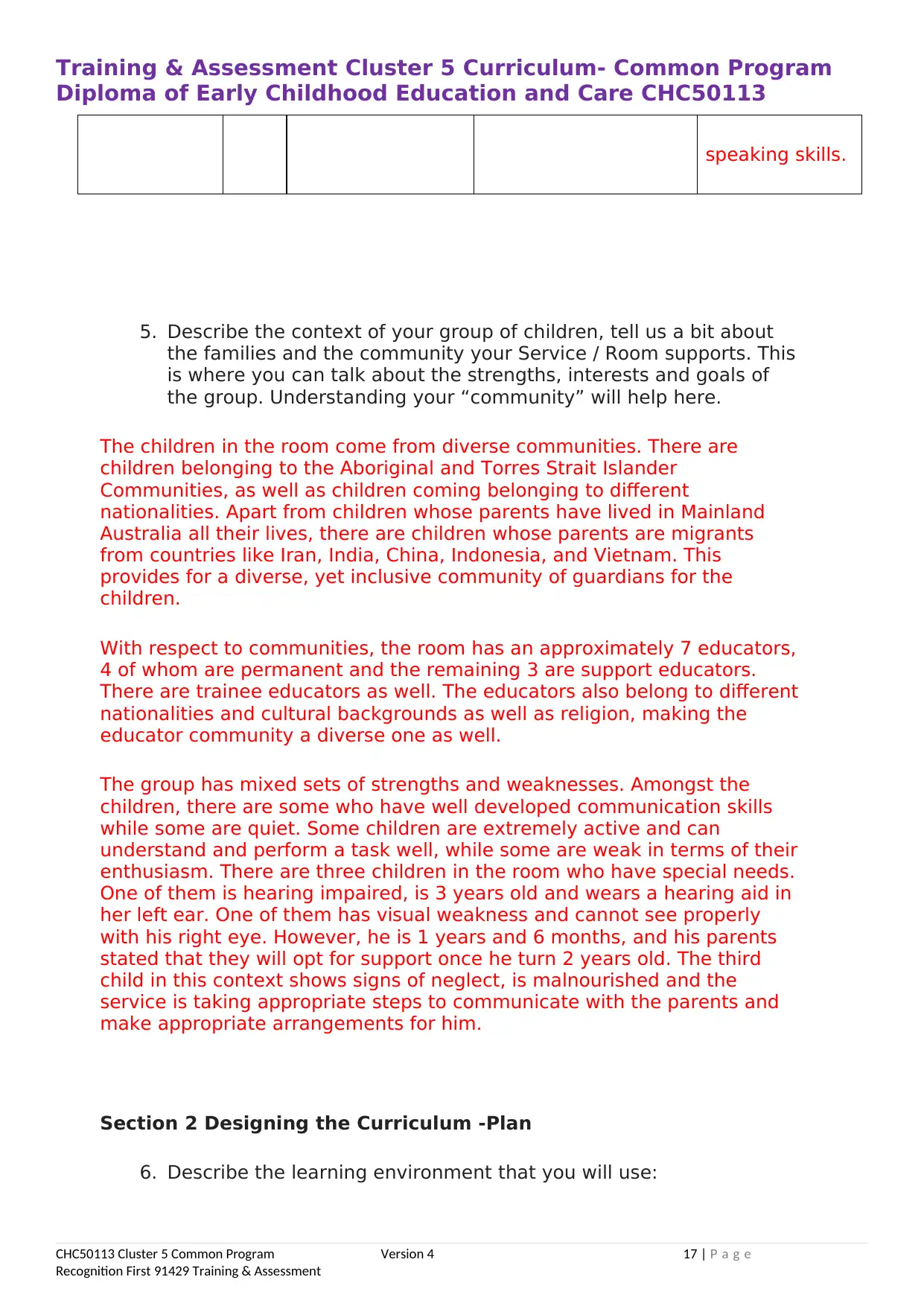
Training & Assessment Cluster 5 Curriculum- Common Program
Diploma of Early Childhood Education and Care CHC50113
speaking skills.
5. Describe the context of your group of children, tell us a bit about
the families and the community your Service / Room supports. This
is where you can talk about the strengths, interests and goals of
the group. Understanding your “community” will help here.
The children in the room come from diverse communities. There are
children belonging to the Aboriginal and Torres Strait Islander
Communities, as well as children coming belonging to different
nationalities. Apart from children whose parents have lived in Mainland
Australia all their lives, there are children whose parents are migrants
from countries like Iran, India, China, Indonesia, and Vietnam. This
provides for a diverse, yet inclusive community of guardians for the
children.
With respect to communities, the room has an approximately 7 educators,
4 of whom are permanent and the remaining 3 are support educators.
There are trainee educators as well. The educators also belong to different
nationalities and cultural backgrounds as well as religion, making the
educator community a diverse one as well.
The group has mixed sets of strengths and weaknesses. Amongst the
children, there are some who have well developed communication skills
while some are quiet. Some children are extremely active and can
understand and perform a task well, while some are weak in terms of their
enthusiasm. There are three children in the room who have special needs.
One of them is hearing impaired, is 3 years old and wears a hearing aid in
her left ear. One of them has visual weakness and cannot see properly
with his right eye. However, he is 1 years and 6 months, and his parents
stated that they will opt for support once he turn 2 years old. The third
child in this context shows signs of neglect, is malnourished and the
service is taking appropriate steps to communicate with the parents and
make appropriate arrangements for him.
Section 2 Designing the Curriculum -Plan
6. Describe the learning environment that you will use:
CHC50113 Cluster 5 Common Program Version 4 17 | P a g e
Recognition First 91429 Training & Assessment
Diploma of Early Childhood Education and Care CHC50113
speaking skills.
5. Describe the context of your group of children, tell us a bit about
the families and the community your Service / Room supports. This
is where you can talk about the strengths, interests and goals of
the group. Understanding your “community” will help here.
The children in the room come from diverse communities. There are
children belonging to the Aboriginal and Torres Strait Islander
Communities, as well as children coming belonging to different
nationalities. Apart from children whose parents have lived in Mainland
Australia all their lives, there are children whose parents are migrants
from countries like Iran, India, China, Indonesia, and Vietnam. This
provides for a diverse, yet inclusive community of guardians for the
children.
With respect to communities, the room has an approximately 7 educators,
4 of whom are permanent and the remaining 3 are support educators.
There are trainee educators as well. The educators also belong to different
nationalities and cultural backgrounds as well as religion, making the
educator community a diverse one as well.
The group has mixed sets of strengths and weaknesses. Amongst the
children, there are some who have well developed communication skills
while some are quiet. Some children are extremely active and can
understand and perform a task well, while some are weak in terms of their
enthusiasm. There are three children in the room who have special needs.
One of them is hearing impaired, is 3 years old and wears a hearing aid in
her left ear. One of them has visual weakness and cannot see properly
with his right eye. However, he is 1 years and 6 months, and his parents
stated that they will opt for support once he turn 2 years old. The third
child in this context shows signs of neglect, is malnourished and the
service is taking appropriate steps to communicate with the parents and
make appropriate arrangements for him.
Section 2 Designing the Curriculum -Plan
6. Describe the learning environment that you will use:
CHC50113 Cluster 5 Common Program Version 4 17 | P a g e
Recognition First 91429 Training & Assessment
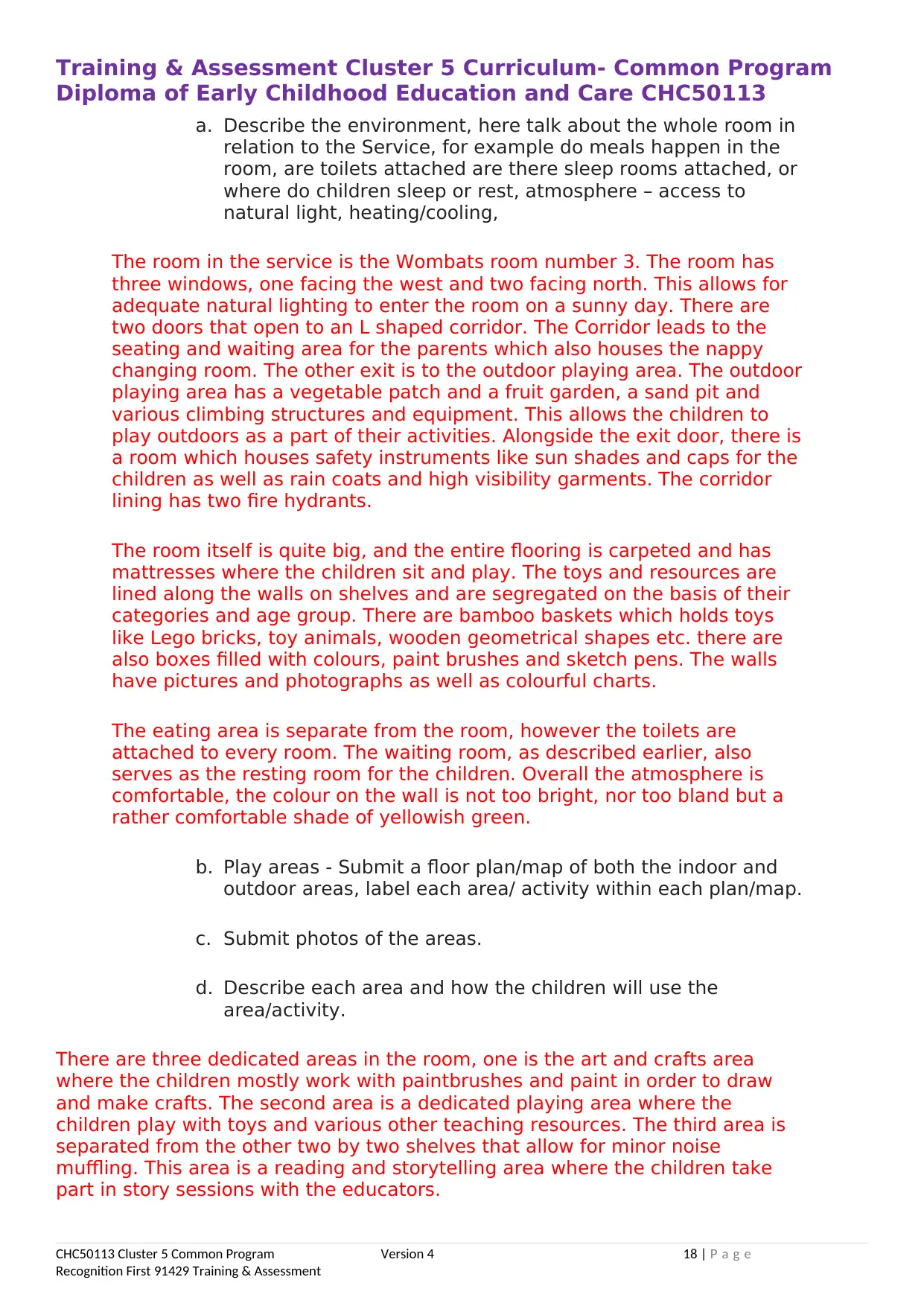
Training & Assessment Cluster 5 Curriculum- Common Program
Diploma of Early Childhood Education and Care CHC50113
a. Describe the environment, here talk about the whole room in
relation to the Service, for example do meals happen in the
room, are toilets attached are there sleep rooms attached, or
where do children sleep or rest, atmosphere – access to
natural light, heating/cooling,
The room in the service is the Wombats room number 3. The room has
three windows, one facing the west and two facing north. This allows for
adequate natural lighting to enter the room on a sunny day. There are
two doors that open to an L shaped corridor. The Corridor leads to the
seating and waiting area for the parents which also houses the nappy
changing room. The other exit is to the outdoor playing area. The outdoor
playing area has a vegetable patch and a fruit garden, a sand pit and
various climbing structures and equipment. This allows the children to
play outdoors as a part of their activities. Alongside the exit door, there is
a room which houses safety instruments like sun shades and caps for the
children as well as rain coats and high visibility garments. The corridor
lining has two fire hydrants.
The room itself is quite big, and the entire flooring is carpeted and has
mattresses where the children sit and play. The toys and resources are
lined along the walls on shelves and are segregated on the basis of their
categories and age group. There are bamboo baskets which holds toys
like Lego bricks, toy animals, wooden geometrical shapes etc. there are
also boxes filled with colours, paint brushes and sketch pens. The walls
have pictures and photographs as well as colourful charts.
The eating area is separate from the room, however the toilets are
attached to every room. The waiting room, as described earlier, also
serves as the resting room for the children. Overall the atmosphere is
comfortable, the colour on the wall is not too bright, nor too bland but a
rather comfortable shade of yellowish green.
b. Play areas - Submit a floor plan/map of both the indoor and
outdoor areas, label each area/ activity within each plan/map.
c. Submit photos of the areas.
d. Describe each area and how the children will use the
area/activity.
There are three dedicated areas in the room, one is the art and crafts area
where the children mostly work with paintbrushes and paint in order to draw
and make crafts. The second area is a dedicated playing area where the
children play with toys and various other teaching resources. The third area is
separated from the other two by two shelves that allow for minor noise
muffling. This area is a reading and storytelling area where the children take
part in story sessions with the educators.
CHC50113 Cluster 5 Common Program Version 4 18 | P a g e
Recognition First 91429 Training & Assessment
Diploma of Early Childhood Education and Care CHC50113
a. Describe the environment, here talk about the whole room in
relation to the Service, for example do meals happen in the
room, are toilets attached are there sleep rooms attached, or
where do children sleep or rest, atmosphere – access to
natural light, heating/cooling,
The room in the service is the Wombats room number 3. The room has
three windows, one facing the west and two facing north. This allows for
adequate natural lighting to enter the room on a sunny day. There are
two doors that open to an L shaped corridor. The Corridor leads to the
seating and waiting area for the parents which also houses the nappy
changing room. The other exit is to the outdoor playing area. The outdoor
playing area has a vegetable patch and a fruit garden, a sand pit and
various climbing structures and equipment. This allows the children to
play outdoors as a part of their activities. Alongside the exit door, there is
a room which houses safety instruments like sun shades and caps for the
children as well as rain coats and high visibility garments. The corridor
lining has two fire hydrants.
The room itself is quite big, and the entire flooring is carpeted and has
mattresses where the children sit and play. The toys and resources are
lined along the walls on shelves and are segregated on the basis of their
categories and age group. There are bamboo baskets which holds toys
like Lego bricks, toy animals, wooden geometrical shapes etc. there are
also boxes filled with colours, paint brushes and sketch pens. The walls
have pictures and photographs as well as colourful charts.
The eating area is separate from the room, however the toilets are
attached to every room. The waiting room, as described earlier, also
serves as the resting room for the children. Overall the atmosphere is
comfortable, the colour on the wall is not too bright, nor too bland but a
rather comfortable shade of yellowish green.
b. Play areas - Submit a floor plan/map of both the indoor and
outdoor areas, label each area/ activity within each plan/map.
c. Submit photos of the areas.
d. Describe each area and how the children will use the
area/activity.
There are three dedicated areas in the room, one is the art and crafts area
where the children mostly work with paintbrushes and paint in order to draw
and make crafts. The second area is a dedicated playing area where the
children play with toys and various other teaching resources. The third area is
separated from the other two by two shelves that allow for minor noise
muffling. This area is a reading and storytelling area where the children take
part in story sessions with the educators.
CHC50113 Cluster 5 Common Program Version 4 18 | P a g e
Recognition First 91429 Training & Assessment
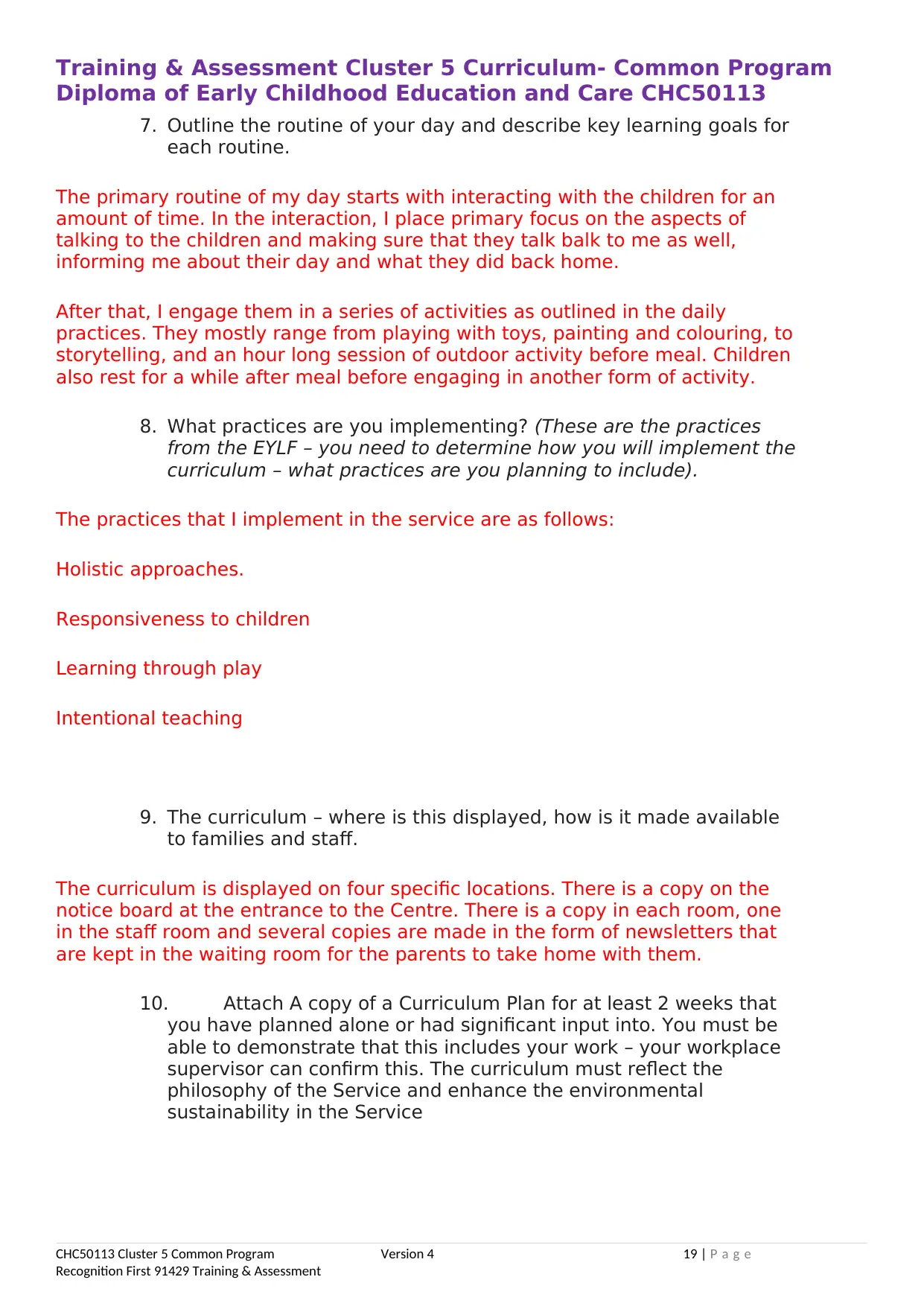
Training & Assessment Cluster 5 Curriculum- Common Program
Diploma of Early Childhood Education and Care CHC50113
7. Outline the routine of your day and describe key learning goals for
each routine.
The primary routine of my day starts with interacting with the children for an
amount of time. In the interaction, I place primary focus on the aspects of
talking to the children and making sure that they talk balk to me as well,
informing me about their day and what they did back home.
After that, I engage them in a series of activities as outlined in the daily
practices. They mostly range from playing with toys, painting and colouring, to
storytelling, and an hour long session of outdoor activity before meal. Children
also rest for a while after meal before engaging in another form of activity.
8. What practices are you implementing? (These are the practices
from the EYLF – you need to determine how you will implement the
curriculum – what practices are you planning to include).
The practices that I implement in the service are as follows:
Holistic approaches.
Responsiveness to children
Learning through play
Intentional teaching
9. The curriculum – where is this displayed, how is it made available
to families and staff.
The curriculum is displayed on four specific locations. There is a copy on the
notice board at the entrance to the Centre. There is a copy in each room, one
in the staff room and several copies are made in the form of newsletters that
are kept in the waiting room for the parents to take home with them.
10. Attach A copy of a Curriculum Plan for at least 2 weeks that
you have planned alone or had significant input into. You must be
able to demonstrate that this includes your work – your workplace
supervisor can confirm this. The curriculum must reflect the
philosophy of the Service and enhance the environmental
sustainability in the Service
CHC50113 Cluster 5 Common Program Version 4 19 | P a g e
Recognition First 91429 Training & Assessment
Diploma of Early Childhood Education and Care CHC50113
7. Outline the routine of your day and describe key learning goals for
each routine.
The primary routine of my day starts with interacting with the children for an
amount of time. In the interaction, I place primary focus on the aspects of
talking to the children and making sure that they talk balk to me as well,
informing me about their day and what they did back home.
After that, I engage them in a series of activities as outlined in the daily
practices. They mostly range from playing with toys, painting and colouring, to
storytelling, and an hour long session of outdoor activity before meal. Children
also rest for a while after meal before engaging in another form of activity.
8. What practices are you implementing? (These are the practices
from the EYLF – you need to determine how you will implement the
curriculum – what practices are you planning to include).
The practices that I implement in the service are as follows:
Holistic approaches.
Responsiveness to children
Learning through play
Intentional teaching
9. The curriculum – where is this displayed, how is it made available
to families and staff.
The curriculum is displayed on four specific locations. There is a copy on the
notice board at the entrance to the Centre. There is a copy in each room, one
in the staff room and several copies are made in the form of newsletters that
are kept in the waiting room for the parents to take home with them.
10. Attach A copy of a Curriculum Plan for at least 2 weeks that
you have planned alone or had significant input into. You must be
able to demonstrate that this includes your work – your workplace
supervisor can confirm this. The curriculum must reflect the
philosophy of the Service and enhance the environmental
sustainability in the Service
CHC50113 Cluster 5 Common Program Version 4 19 | P a g e
Recognition First 91429 Training & Assessment
Paraphrase This Document
Need a fresh take? Get an instant paraphrase of this document with our AI Paraphraser
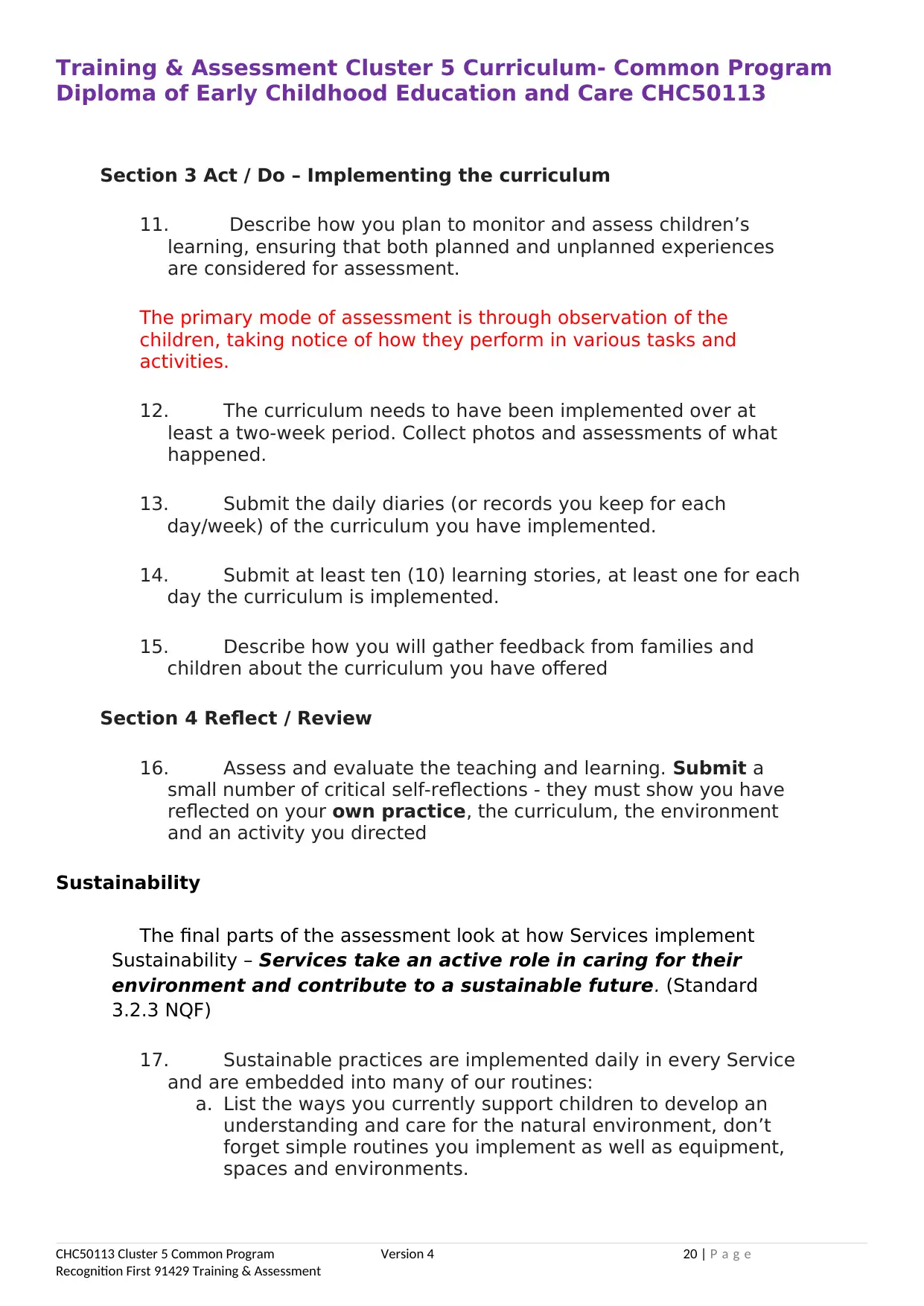
Training & Assessment Cluster 5 Curriculum- Common Program
Diploma of Early Childhood Education and Care CHC50113
Section 3 Act / Do – Implementing the curriculum
11. Describe how you plan to monitor and assess children’s
learning, ensuring that both planned and unplanned experiences
are considered for assessment.
The primary mode of assessment is through observation of the
children, taking notice of how they perform in various tasks and
activities.
12. The curriculum needs to have been implemented over at
least a two-week period. Collect photos and assessments of what
happened.
13. Submit the daily diaries (or records you keep for each
day/week) of the curriculum you have implemented.
14. Submit at least ten (10) learning stories, at least one for each
day the curriculum is implemented.
15. Describe how you will gather feedback from families and
children about the curriculum you have offered
Section 4 Reflect / Review
16. Assess and evaluate the teaching and learning. Submit a
small number of critical self-reflections - they must show you have
reflected on your own practice, the curriculum, the environment
and an activity you directed
Sustainability
The final parts of the assessment look at how Services implement
Sustainability – Services take an active role in caring for their
environment and contribute to a sustainable future. (Standard
3.2.3 NQF)
17. Sustainable practices are implemented daily in every Service
and are embedded into many of our routines:
a. List the ways you currently support children to develop an
understanding and care for the natural environment, don’t
forget simple routines you implement as well as equipment,
spaces and environments.
CHC50113 Cluster 5 Common Program Version 4 20 | P a g e
Recognition First 91429 Training & Assessment
Diploma of Early Childhood Education and Care CHC50113
Section 3 Act / Do – Implementing the curriculum
11. Describe how you plan to monitor and assess children’s
learning, ensuring that both planned and unplanned experiences
are considered for assessment.
The primary mode of assessment is through observation of the
children, taking notice of how they perform in various tasks and
activities.
12. The curriculum needs to have been implemented over at
least a two-week period. Collect photos and assessments of what
happened.
13. Submit the daily diaries (or records you keep for each
day/week) of the curriculum you have implemented.
14. Submit at least ten (10) learning stories, at least one for each
day the curriculum is implemented.
15. Describe how you will gather feedback from families and
children about the curriculum you have offered
Section 4 Reflect / Review
16. Assess and evaluate the teaching and learning. Submit a
small number of critical self-reflections - they must show you have
reflected on your own practice, the curriculum, the environment
and an activity you directed
Sustainability
The final parts of the assessment look at how Services implement
Sustainability – Services take an active role in caring for their
environment and contribute to a sustainable future. (Standard
3.2.3 NQF)
17. Sustainable practices are implemented daily in every Service
and are embedded into many of our routines:
a. List the ways you currently support children to develop an
understanding and care for the natural environment, don’t
forget simple routines you implement as well as equipment,
spaces and environments.
CHC50113 Cluster 5 Common Program Version 4 20 | P a g e
Recognition First 91429 Training & Assessment
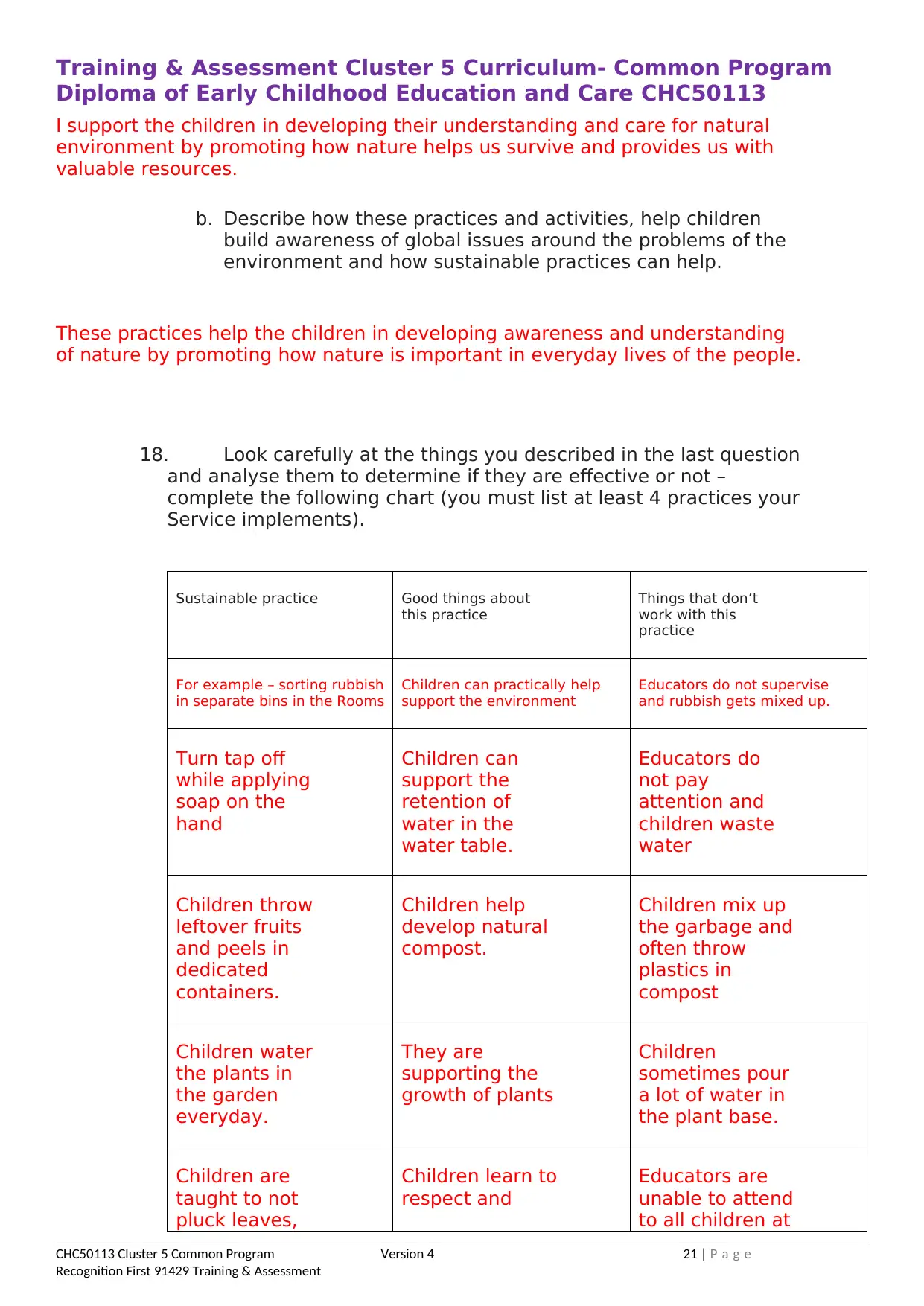
Training & Assessment Cluster 5 Curriculum- Common Program
Diploma of Early Childhood Education and Care CHC50113
I support the children in developing their understanding and care for natural
environment by promoting how nature helps us survive and provides us with
valuable resources.
b. Describe how these practices and activities, help children
build awareness of global issues around the problems of the
environment and how sustainable practices can help.
These practices help the children in developing awareness and understanding
of nature by promoting how nature is important in everyday lives of the people.
18. Look carefully at the things you described in the last question
and analyse them to determine if they are effective or not –
complete the following chart (you must list at least 4 practices your
Service implements).
Sustainable practice Good things about
this practice
Things that don’t
work with this
practice
For example – sorting rubbish
in separate bins in the Rooms
Children can practically help
support the environment
Educators do not supervise
and rubbish gets mixed up.
Turn tap off
while applying
soap on the
hand
Children can
support the
retention of
water in the
water table.
Educators do
not pay
attention and
children waste
water
Children throw
leftover fruits
and peels in
dedicated
containers.
Children help
develop natural
compost.
Children mix up
the garbage and
often throw
plastics in
compost
Children water
the plants in
the garden
everyday.
They are
supporting the
growth of plants
Children
sometimes pour
a lot of water in
the plant base.
Children are
taught to not
pluck leaves,
Children learn to
respect and
Educators are
unable to attend
to all children at
CHC50113 Cluster 5 Common Program Version 4 21 | P a g e
Recognition First 91429 Training & Assessment
Diploma of Early Childhood Education and Care CHC50113
I support the children in developing their understanding and care for natural
environment by promoting how nature helps us survive and provides us with
valuable resources.
b. Describe how these practices and activities, help children
build awareness of global issues around the problems of the
environment and how sustainable practices can help.
These practices help the children in developing awareness and understanding
of nature by promoting how nature is important in everyday lives of the people.
18. Look carefully at the things you described in the last question
and analyse them to determine if they are effective or not –
complete the following chart (you must list at least 4 practices your
Service implements).
Sustainable practice Good things about
this practice
Things that don’t
work with this
practice
For example – sorting rubbish
in separate bins in the Rooms
Children can practically help
support the environment
Educators do not supervise
and rubbish gets mixed up.
Turn tap off
while applying
soap on the
hand
Children can
support the
retention of
water in the
water table.
Educators do
not pay
attention and
children waste
water
Children throw
leftover fruits
and peels in
dedicated
containers.
Children help
develop natural
compost.
Children mix up
the garbage and
often throw
plastics in
compost
Children water
the plants in
the garden
everyday.
They are
supporting the
growth of plants
Children
sometimes pour
a lot of water in
the plant base.
Children are
taught to not
pluck leaves,
Children learn to
respect and
Educators are
unable to attend
to all children at
CHC50113 Cluster 5 Common Program Version 4 21 | P a g e
Recognition First 91429 Training & Assessment
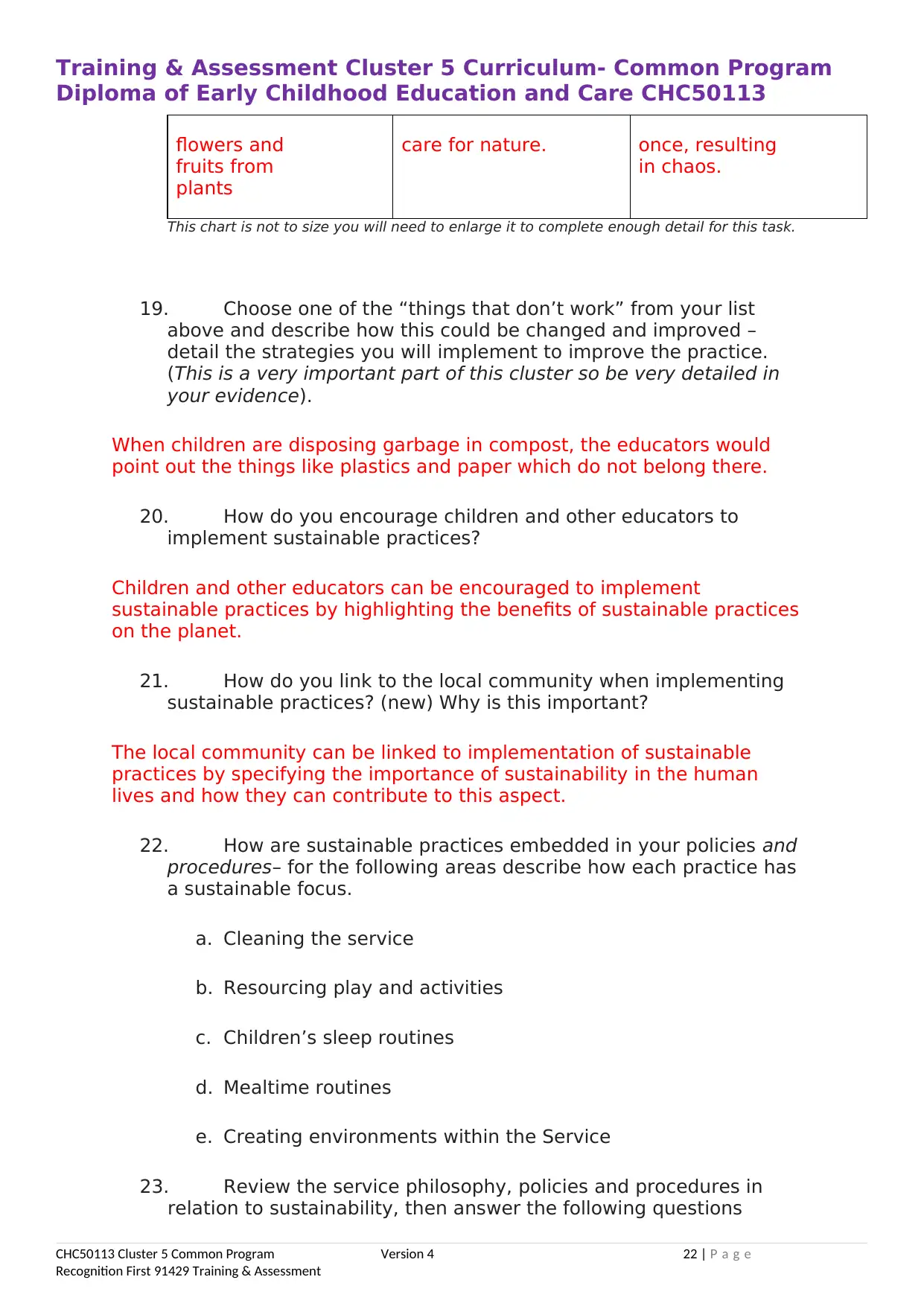
Training & Assessment Cluster 5 Curriculum- Common Program
Diploma of Early Childhood Education and Care CHC50113
flowers and
fruits from
plants
care for nature. once, resulting
in chaos.
This chart is not to size you will need to enlarge it to complete enough detail for this task.
19. Choose one of the “things that don’t work” from your list
above and describe how this could be changed and improved –
detail the strategies you will implement to improve the practice.
(This is a very important part of this cluster so be very detailed in
your evidence).
When children are disposing garbage in compost, the educators would
point out the things like plastics and paper which do not belong there.
20. How do you encourage children and other educators to
implement sustainable practices?
Children and other educators can be encouraged to implement
sustainable practices by highlighting the benefits of sustainable practices
on the planet.
21. How do you link to the local community when implementing
sustainable practices? (new) Why is this important?
The local community can be linked to implementation of sustainable
practices by specifying the importance of sustainability in the human
lives and how they can contribute to this aspect.
22. How are sustainable practices embedded in your policies and
procedures– for the following areas describe how each practice has
a sustainable focus.
a. Cleaning the service
b. Resourcing play and activities
c. Children’s sleep routines
d. Mealtime routines
e. Creating environments within the Service
23. Review the service philosophy, policies and procedures in
relation to sustainability, then answer the following questions
CHC50113 Cluster 5 Common Program Version 4 22 | P a g e
Recognition First 91429 Training & Assessment
Diploma of Early Childhood Education and Care CHC50113
flowers and
fruits from
plants
care for nature. once, resulting
in chaos.
This chart is not to size you will need to enlarge it to complete enough detail for this task.
19. Choose one of the “things that don’t work” from your list
above and describe how this could be changed and improved –
detail the strategies you will implement to improve the practice.
(This is a very important part of this cluster so be very detailed in
your evidence).
When children are disposing garbage in compost, the educators would
point out the things like plastics and paper which do not belong there.
20. How do you encourage children and other educators to
implement sustainable practices?
Children and other educators can be encouraged to implement
sustainable practices by highlighting the benefits of sustainable practices
on the planet.
21. How do you link to the local community when implementing
sustainable practices? (new) Why is this important?
The local community can be linked to implementation of sustainable
practices by specifying the importance of sustainability in the human
lives and how they can contribute to this aspect.
22. How are sustainable practices embedded in your policies and
procedures– for the following areas describe how each practice has
a sustainable focus.
a. Cleaning the service
b. Resourcing play and activities
c. Children’s sleep routines
d. Mealtime routines
e. Creating environments within the Service
23. Review the service philosophy, policies and procedures in
relation to sustainability, then answer the following questions
CHC50113 Cluster 5 Common Program Version 4 22 | P a g e
Recognition First 91429 Training & Assessment
Secure Best Marks with AI Grader
Need help grading? Try our AI Grader for instant feedback on your assignments.
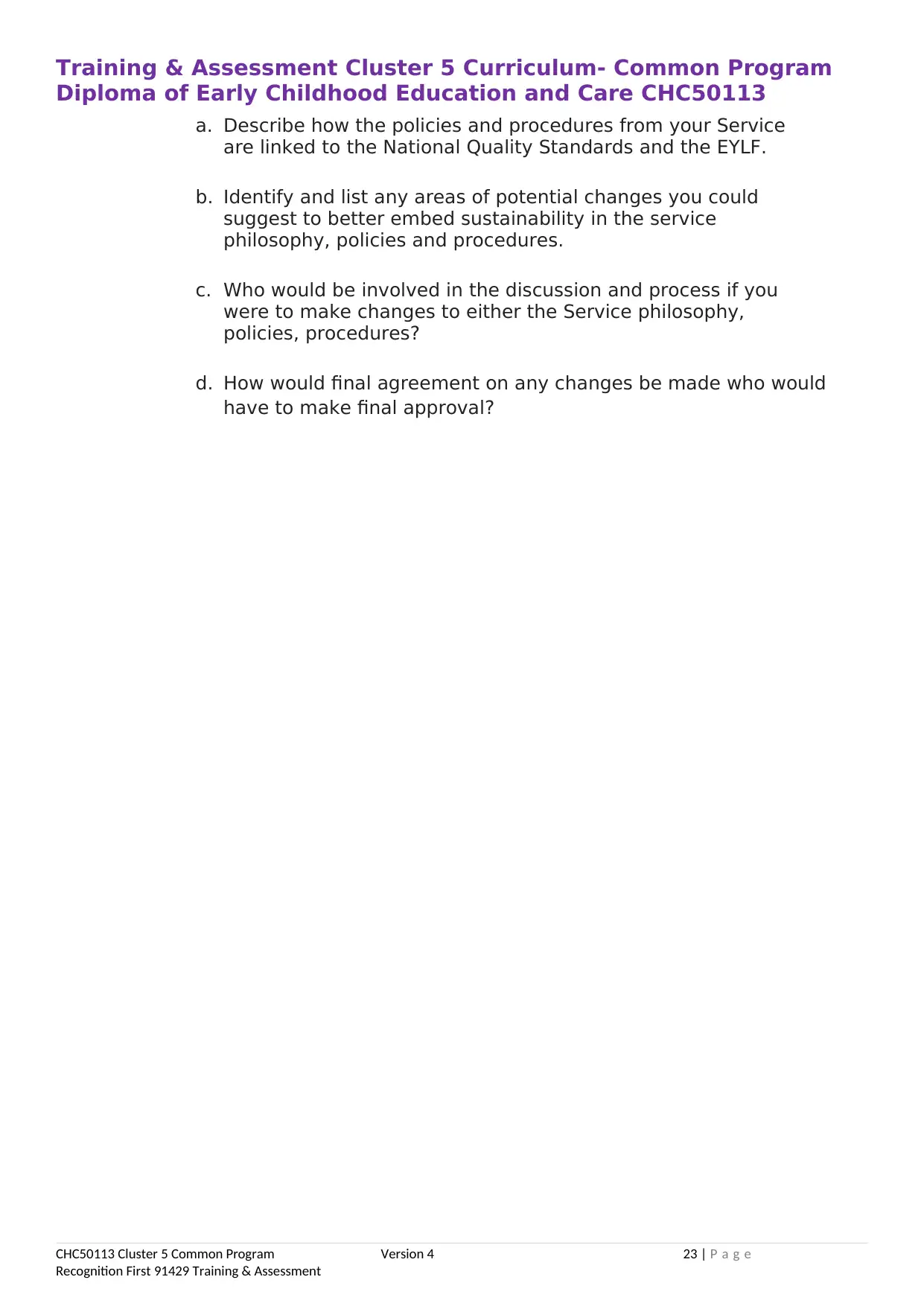
Training & Assessment Cluster 5 Curriculum- Common Program
Diploma of Early Childhood Education and Care CHC50113
a. Describe how the policies and procedures from your Service
are linked to the National Quality Standards and the EYLF.
b. Identify and list any areas of potential changes you could
suggest to better embed sustainability in the service
philosophy, policies and procedures.
c. Who would be involved in the discussion and process if you
were to make changes to either the Service philosophy,
policies, procedures?
d. How would final agreement on any changes be made who would
have to make final approval?
CHC50113 Cluster 5 Common Program Version 4 23 | P a g e
Recognition First 91429 Training & Assessment
Diploma of Early Childhood Education and Care CHC50113
a. Describe how the policies and procedures from your Service
are linked to the National Quality Standards and the EYLF.
b. Identify and list any areas of potential changes you could
suggest to better embed sustainability in the service
philosophy, policies and procedures.
c. Who would be involved in the discussion and process if you
were to make changes to either the Service philosophy,
policies, procedures?
d. How would final agreement on any changes be made who would
have to make final approval?
CHC50113 Cluster 5 Common Program Version 4 23 | P a g e
Recognition First 91429 Training & Assessment
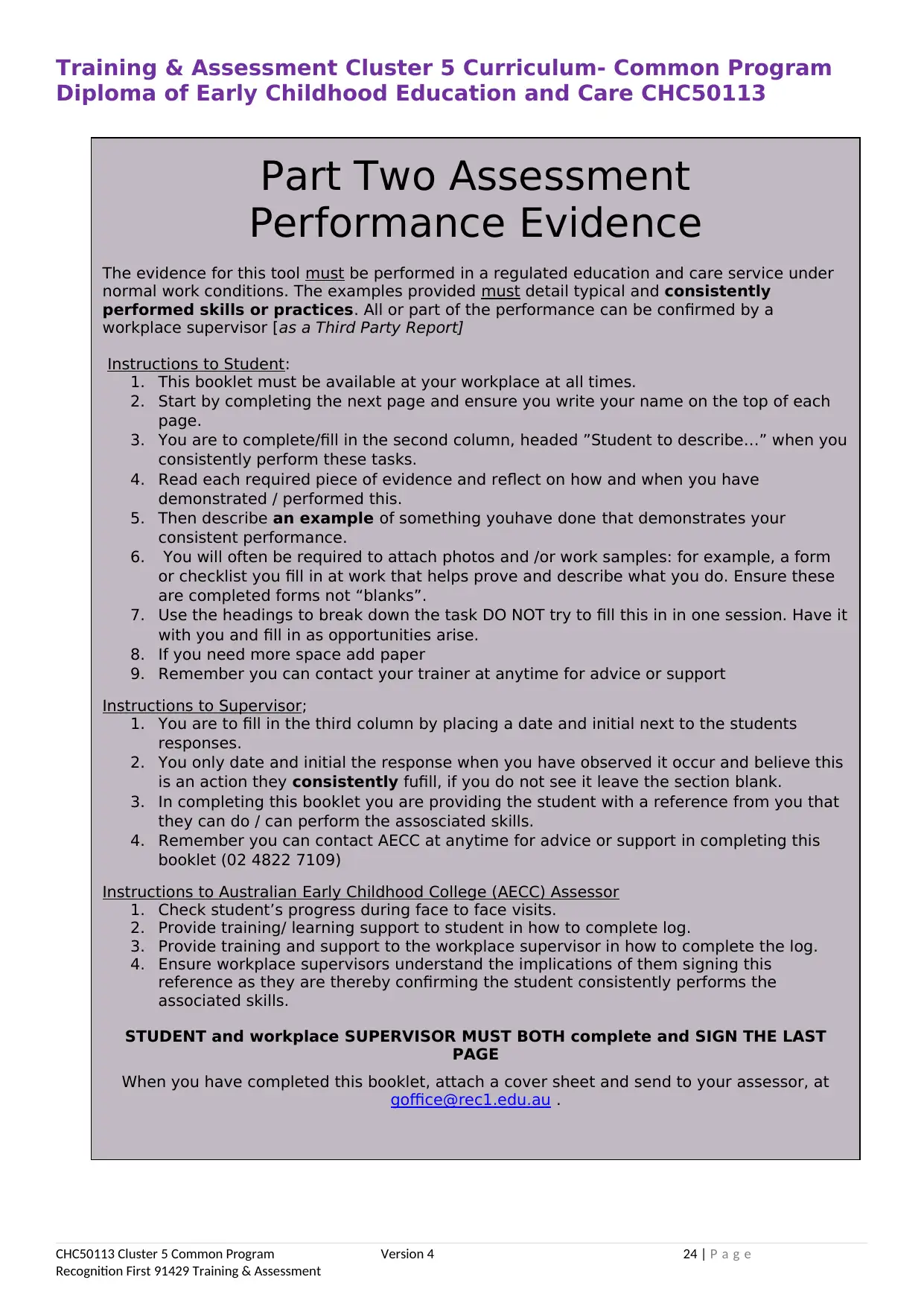
Training & Assessment Cluster 5 Curriculum- Common Program
Diploma of Early Childhood Education and Care CHC50113
CHC50113 Cluster 5 Common Program Version 4 24 | P a g e
Recognition First 91429 Training & Assessment
Part Two Assessment
Performance Evidence
The evidence for this tool must be performed in a regulated education and care service under
normal work conditions. The examples provided must detail typical and consistently
performed skills or practices. All or part of the performance can be confirmed by a
workplace supervisor [as a Third Party Report]
Instructions to Student:
1. This booklet must be available at your workplace at all times.
2. Start by completing the next page and ensure you write your name on the top of each
page.
3. You are to complete/fill in the second column, headed ”Student to describe…” when you
consistently perform these tasks.
4. Read each required piece of evidence and reflect on how and when you have
demonstrated / performed this.
5. Then describe an example of something youhave done that demonstrates your
consistent performance.
6. You will often be required to attach photos and /or work samples: for example, a form
or checklist you fill in at work that helps prove and describe what you do. Ensure these
are completed forms not “blanks”.
7. Use the headings to break down the task DO NOT try to fill this in in one session. Have it
with you and fill in as opportunities arise.
8. If you need more space add paper
9. Remember you can contact your trainer at anytime for advice or support
Instructions to Supervisor;
1. You are to fill in the third column by placing a date and initial next to the students
responses.
2. You only date and initial the response when you have observed it occur and believe this
is an action they consistently fufill, if you do not see it leave the section blank.
3. In completing this booklet you are providing the student with a reference from you that
they can do / can perform the assosciated skills.
4. Remember you can contact AECC at anytime for advice or support in completing this
booklet (02 4822 7109)
Instructions to Australian Early Childhood College (AECC) Assessor
1. Check student’s progress during face to face visits.
2. Provide training/ learning support to student in how to complete log.
3. Provide training and support to the workplace supervisor in how to complete the log.
4. Ensure workplace supervisors understand the implications of them signing this
reference as they are thereby confirming the student consistently performs the
associated skills.
STUDENT and workplace SUPERVISOR MUST BOTH complete and SIGN THE LAST
PAGE
When you have completed this booklet, attach a cover sheet and send to your assessor, at
goffice@rec1.edu.au .
Diploma of Early Childhood Education and Care CHC50113
CHC50113 Cluster 5 Common Program Version 4 24 | P a g e
Recognition First 91429 Training & Assessment
Part Two Assessment
Performance Evidence
The evidence for this tool must be performed in a regulated education and care service under
normal work conditions. The examples provided must detail typical and consistently
performed skills or practices. All or part of the performance can be confirmed by a
workplace supervisor [as a Third Party Report]
Instructions to Student:
1. This booklet must be available at your workplace at all times.
2. Start by completing the next page and ensure you write your name on the top of each
page.
3. You are to complete/fill in the second column, headed ”Student to describe…” when you
consistently perform these tasks.
4. Read each required piece of evidence and reflect on how and when you have
demonstrated / performed this.
5. Then describe an example of something youhave done that demonstrates your
consistent performance.
6. You will often be required to attach photos and /or work samples: for example, a form
or checklist you fill in at work that helps prove and describe what you do. Ensure these
are completed forms not “blanks”.
7. Use the headings to break down the task DO NOT try to fill this in in one session. Have it
with you and fill in as opportunities arise.
8. If you need more space add paper
9. Remember you can contact your trainer at anytime for advice or support
Instructions to Supervisor;
1. You are to fill in the third column by placing a date and initial next to the students
responses.
2. You only date and initial the response when you have observed it occur and believe this
is an action they consistently fufill, if you do not see it leave the section blank.
3. In completing this booklet you are providing the student with a reference from you that
they can do / can perform the assosciated skills.
4. Remember you can contact AECC at anytime for advice or support in completing this
booklet (02 4822 7109)
Instructions to Australian Early Childhood College (AECC) Assessor
1. Check student’s progress during face to face visits.
2. Provide training/ learning support to student in how to complete log.
3. Provide training and support to the workplace supervisor in how to complete the log.
4. Ensure workplace supervisors understand the implications of them signing this
reference as they are thereby confirming the student consistently performs the
associated skills.
STUDENT and workplace SUPERVISOR MUST BOTH complete and SIGN THE LAST
PAGE
When you have completed this booklet, attach a cover sheet and send to your assessor, at
goffice@rec1.edu.au .
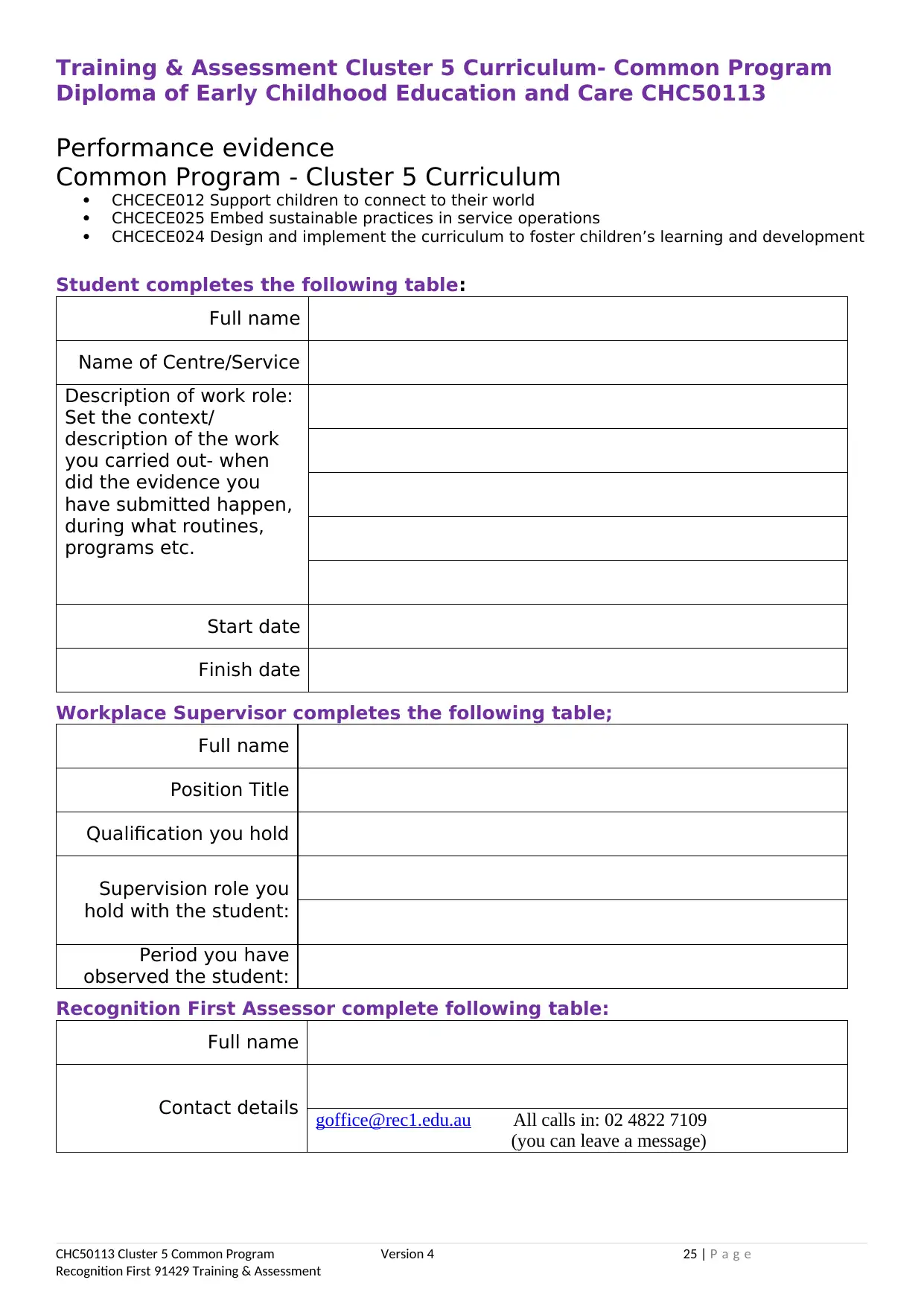
Training & Assessment Cluster 5 Curriculum- Common Program
Diploma of Early Childhood Education and Care CHC50113
Performance evidence
Common Program - Cluster 5 Curriculum
CHCECE012 Support children to connect to their world
CHCECE025 Embed sustainable practices in service operations
CHCECE024 Design and implement the curriculum to foster children’s learning and development
Student completes the following table:
Full name
Name of Centre/Service
Description of work role:
Set the context/
description of the work
you carried out- when
did the evidence you
have submitted happen,
during what routines,
programs etc.
Start date
Finish date
Workplace Supervisor completes the following table;
Full name
Position Title
Qualification you hold
Supervision role you
hold with the student:
Period you have
observed the student:
Recognition First Assessor complete following table:
Full name
Contact details goffice@rec1.edu.au All calls in: 02 4822 7109
(you can leave a message)
CHC50113 Cluster 5 Common Program Version 4 25 | P a g e
Recognition First 91429 Training & Assessment
Diploma of Early Childhood Education and Care CHC50113
Performance evidence
Common Program - Cluster 5 Curriculum
CHCECE012 Support children to connect to their world
CHCECE025 Embed sustainable practices in service operations
CHCECE024 Design and implement the curriculum to foster children’s learning and development
Student completes the following table:
Full name
Name of Centre/Service
Description of work role:
Set the context/
description of the work
you carried out- when
did the evidence you
have submitted happen,
during what routines,
programs etc.
Start date
Finish date
Workplace Supervisor completes the following table;
Full name
Position Title
Qualification you hold
Supervision role you
hold with the student:
Period you have
observed the student:
Recognition First Assessor complete following table:
Full name
Contact details goffice@rec1.edu.au All calls in: 02 4822 7109
(you can leave a message)
CHC50113 Cluster 5 Common Program Version 4 25 | P a g e
Recognition First 91429 Training & Assessment
Paraphrase This Document
Need a fresh take? Get an instant paraphrase of this document with our AI Paraphraser
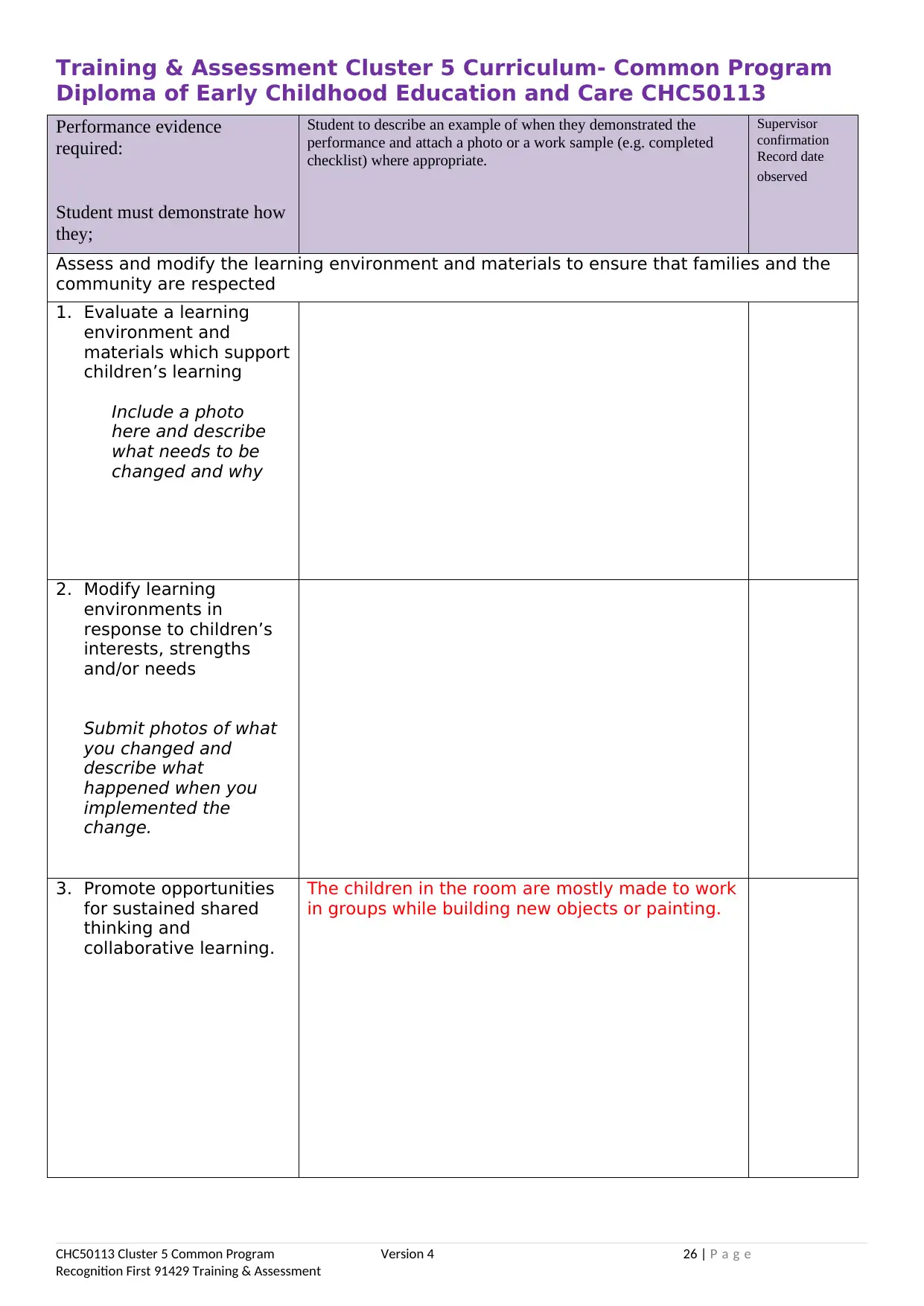
Training & Assessment Cluster 5 Curriculum- Common Program
Diploma of Early Childhood Education and Care CHC50113
Performance evidence
required:
Student must demonstrate how
they;
Student to describe an example of when they demonstrated the
performance and attach a photo or a work sample (e.g. completed
checklist) where appropriate.
Supervisor
confirmation
Record date
observed
Assess and modify the learning environment and materials to ensure that families and the
community are respected
1. Evaluate a learning
environment and
materials which support
children’s learning
Include a photo
here and describe
what needs to be
changed and why
2. Modify learning
environments in
response to children’s
interests, strengths
and/or needs
Submit photos of what
you changed and
describe what
happened when you
implemented the
change.
3. Promote opportunities
for sustained shared
thinking and
collaborative learning.
The children in the room are mostly made to work
in groups while building new objects or painting.
CHC50113 Cluster 5 Common Program Version 4 26 | P a g e
Recognition First 91429 Training & Assessment
Diploma of Early Childhood Education and Care CHC50113
Performance evidence
required:
Student must demonstrate how
they;
Student to describe an example of when they demonstrated the
performance and attach a photo or a work sample (e.g. completed
checklist) where appropriate.
Supervisor
confirmation
Record date
observed
Assess and modify the learning environment and materials to ensure that families and the
community are respected
1. Evaluate a learning
environment and
materials which support
children’s learning
Include a photo
here and describe
what needs to be
changed and why
2. Modify learning
environments in
response to children’s
interests, strengths
and/or needs
Submit photos of what
you changed and
describe what
happened when you
implemented the
change.
3. Promote opportunities
for sustained shared
thinking and
collaborative learning.
The children in the room are mostly made to work
in groups while building new objects or painting.
CHC50113 Cluster 5 Common Program Version 4 26 | P a g e
Recognition First 91429 Training & Assessment
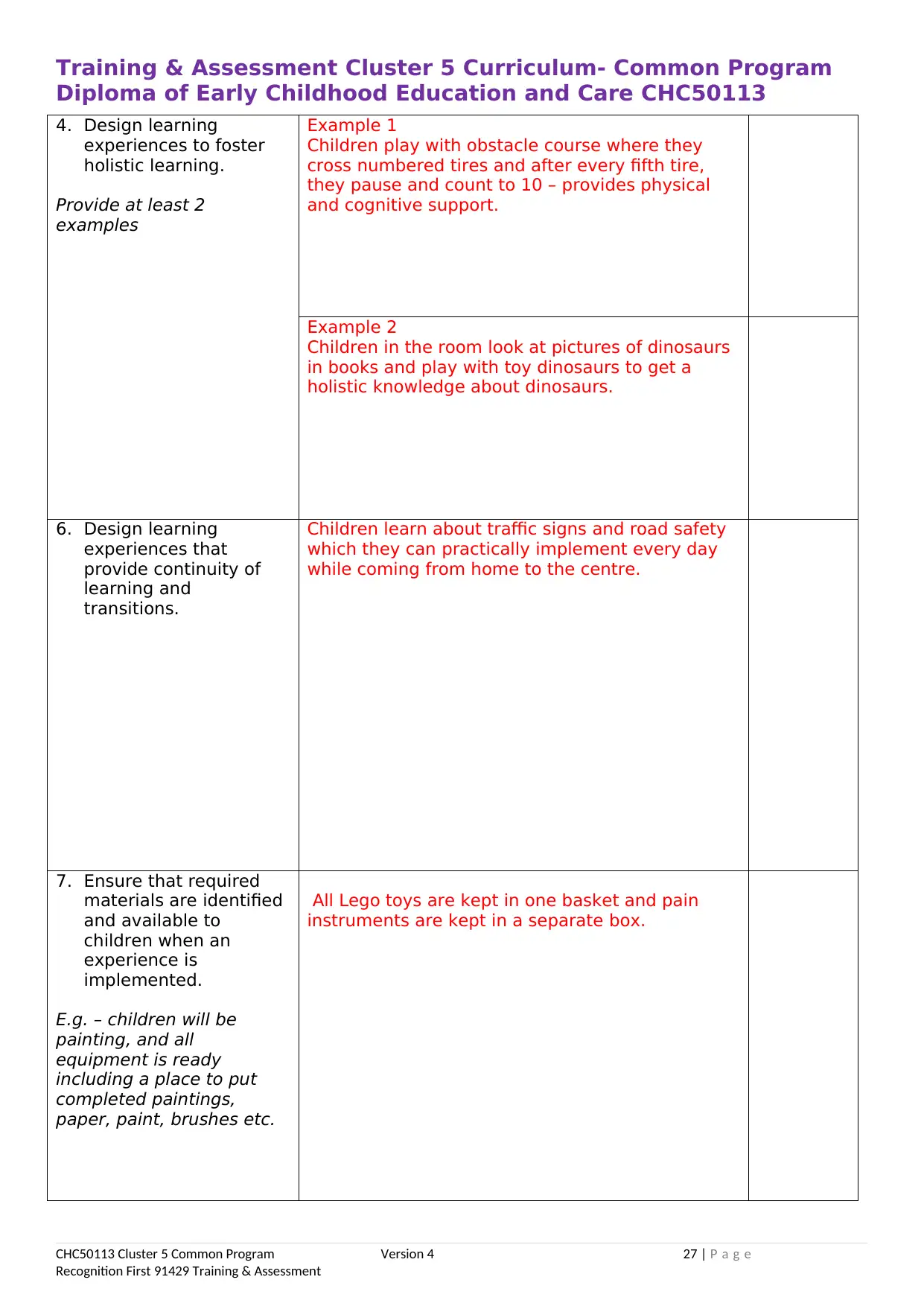
Training & Assessment Cluster 5 Curriculum- Common Program
Diploma of Early Childhood Education and Care CHC50113
4. Design learning
experiences to foster
holistic learning.
Provide at least 2
examples
Example 1
Children play with obstacle course where they
cross numbered tires and after every fifth tire,
they pause and count to 10 – provides physical
and cognitive support.
Example 2
Children in the room look at pictures of dinosaurs
in books and play with toy dinosaurs to get a
holistic knowledge about dinosaurs.
6. Design learning
experiences that
provide continuity of
learning and
transitions.
Children learn about traffic signs and road safety
which they can practically implement every day
while coming from home to the centre.
7. Ensure that required
materials are identified
and available to
children when an
experience is
implemented.
E.g. – children will be
painting, and all
equipment is ready
including a place to put
completed paintings,
paper, paint, brushes etc.
All Lego toys are kept in one basket and pain
instruments are kept in a separate box.
CHC50113 Cluster 5 Common Program Version 4 27 | P a g e
Recognition First 91429 Training & Assessment
Diploma of Early Childhood Education and Care CHC50113
4. Design learning
experiences to foster
holistic learning.
Provide at least 2
examples
Example 1
Children play with obstacle course where they
cross numbered tires and after every fifth tire,
they pause and count to 10 – provides physical
and cognitive support.
Example 2
Children in the room look at pictures of dinosaurs
in books and play with toy dinosaurs to get a
holistic knowledge about dinosaurs.
6. Design learning
experiences that
provide continuity of
learning and
transitions.
Children learn about traffic signs and road safety
which they can practically implement every day
while coming from home to the centre.
7. Ensure that required
materials are identified
and available to
children when an
experience is
implemented.
E.g. – children will be
painting, and all
equipment is ready
including a place to put
completed paintings,
paper, paint, brushes etc.
All Lego toys are kept in one basket and pain
instruments are kept in a separate box.
CHC50113 Cluster 5 Common Program Version 4 27 | P a g e
Recognition First 91429 Training & Assessment
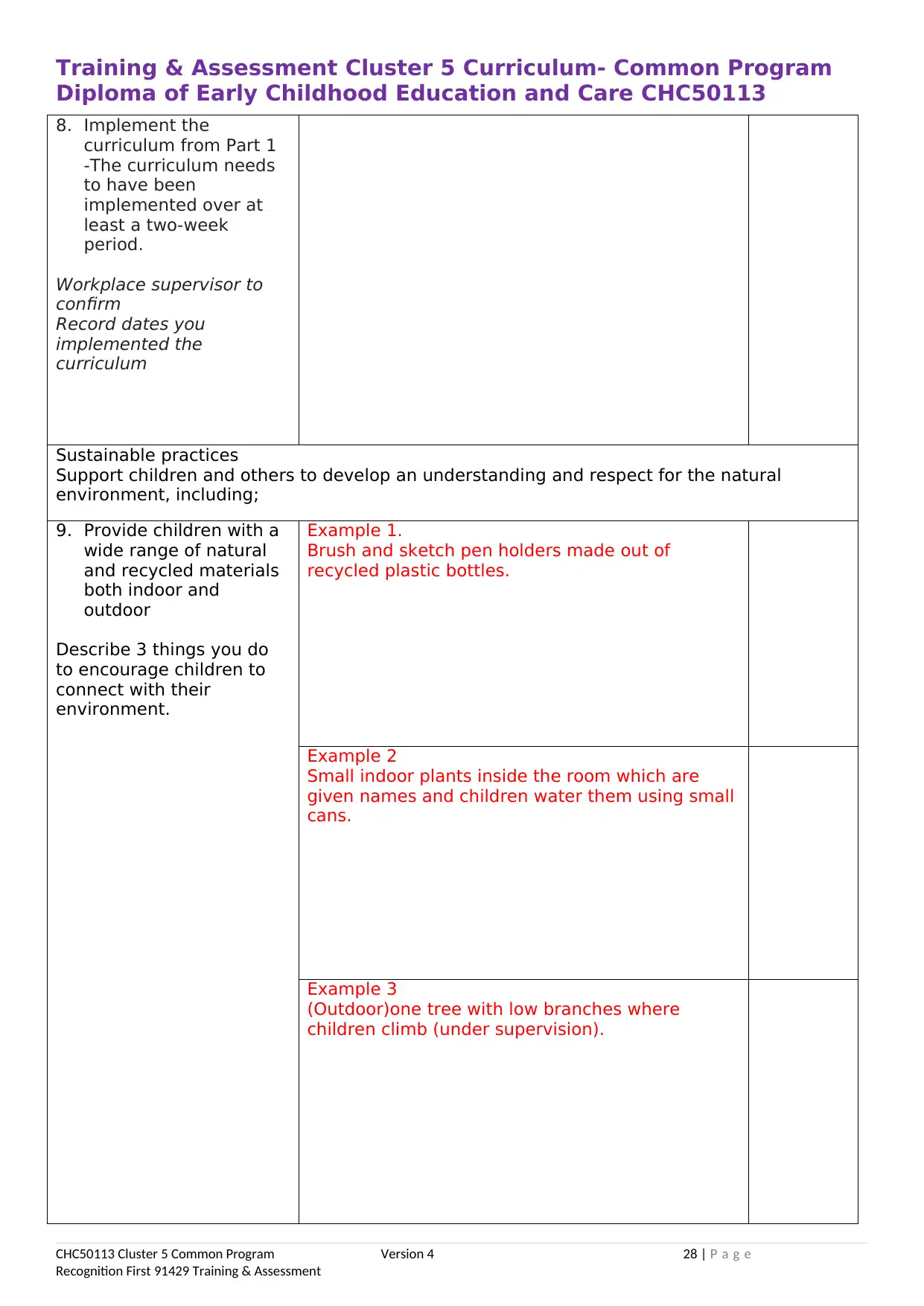
Training & Assessment Cluster 5 Curriculum- Common Program
Diploma of Early Childhood Education and Care CHC50113
8. Implement the
curriculum from Part 1
-The curriculum needs
to have been
implemented over at
least a two-week
period.
Workplace supervisor to
confirm
Record dates you
implemented the
curriculum
Sustainable practices
Support children and others to develop an understanding and respect for the natural
environment, including;
9. Provide children with a
wide range of natural
and recycled materials
both indoor and
outdoor
Describe 3 things you do
to encourage children to
connect with their
environment.
Example 1.
Brush and sketch pen holders made out of
recycled plastic bottles.
Example 2
Small indoor plants inside the room which are
given names and children water them using small
cans.
Example 3
(Outdoor)one tree with low branches where
children climb (under supervision).
CHC50113 Cluster 5 Common Program Version 4 28 | P a g e
Recognition First 91429 Training & Assessment
Diploma of Early Childhood Education and Care CHC50113
8. Implement the
curriculum from Part 1
-The curriculum needs
to have been
implemented over at
least a two-week
period.
Workplace supervisor to
confirm
Record dates you
implemented the
curriculum
Sustainable practices
Support children and others to develop an understanding and respect for the natural
environment, including;
9. Provide children with a
wide range of natural
and recycled materials
both indoor and
outdoor
Describe 3 things you do
to encourage children to
connect with their
environment.
Example 1.
Brush and sketch pen holders made out of
recycled plastic bottles.
Example 2
Small indoor plants inside the room which are
given names and children water them using small
cans.
Example 3
(Outdoor)one tree with low branches where
children climb (under supervision).
CHC50113 Cluster 5 Common Program Version 4 28 | P a g e
Recognition First 91429 Training & Assessment
Secure Best Marks with AI Grader
Need help grading? Try our AI Grader for instant feedback on your assignments.
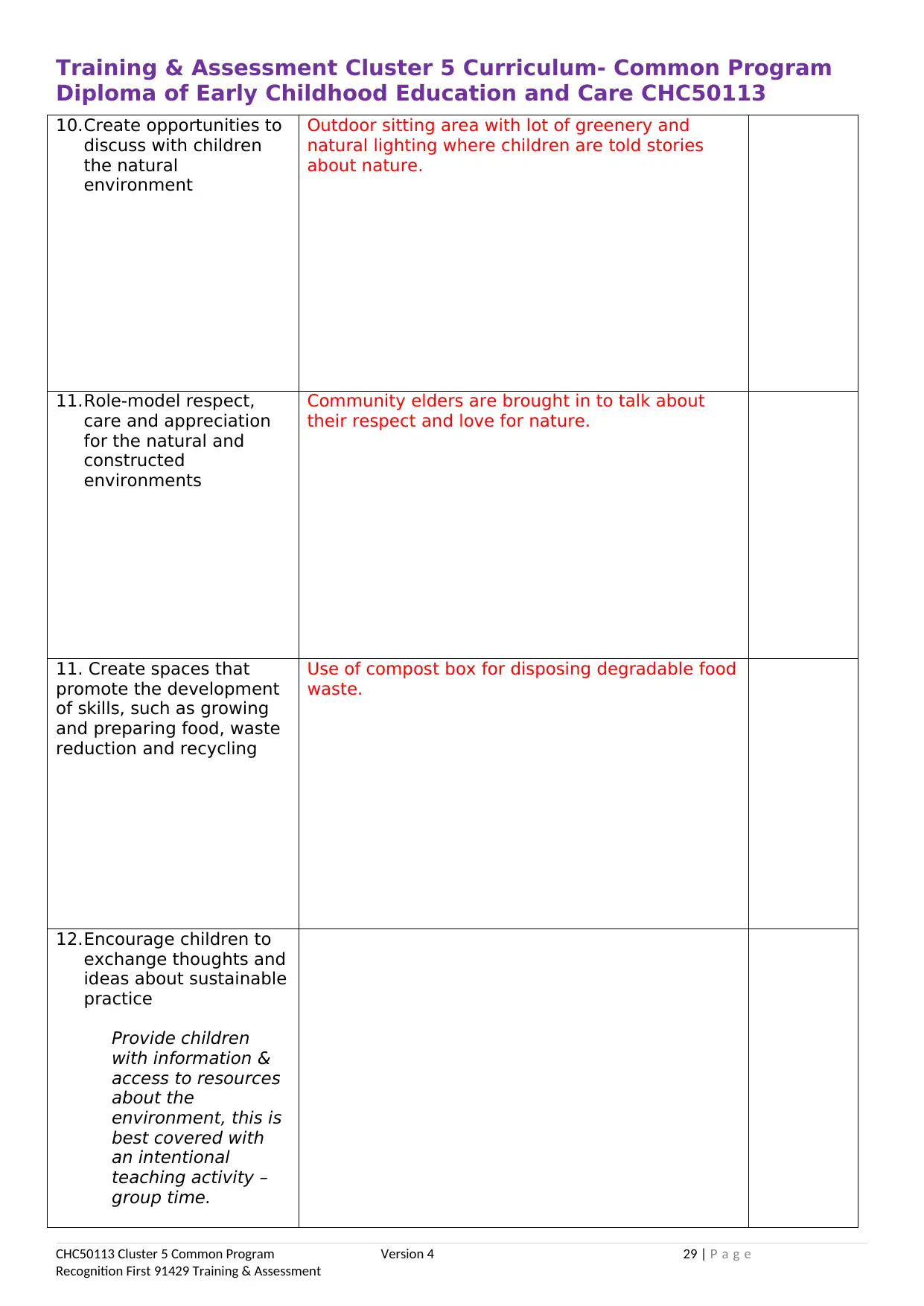
Training & Assessment Cluster 5 Curriculum- Common Program
Diploma of Early Childhood Education and Care CHC50113
10.Create opportunities to
discuss with children
the natural
environment
Outdoor sitting area with lot of greenery and
natural lighting where children are told stories
about nature.
11.Role-model respect,
care and appreciation
for the natural and
constructed
environments
Community elders are brought in to talk about
their respect and love for nature.
11. Create spaces that
promote the development
of skills, such as growing
and preparing food, waste
reduction and recycling
Use of compost box for disposing degradable food
waste.
12.Encourage children to
exchange thoughts and
ideas about sustainable
practice
Provide children
with information &
access to resources
about the
environment, this is
best covered with
an intentional
teaching activity –
group time.
CHC50113 Cluster 5 Common Program Version 4 29 | P a g e
Recognition First 91429 Training & Assessment
Diploma of Early Childhood Education and Care CHC50113
10.Create opportunities to
discuss with children
the natural
environment
Outdoor sitting area with lot of greenery and
natural lighting where children are told stories
about nature.
11.Role-model respect,
care and appreciation
for the natural and
constructed
environments
Community elders are brought in to talk about
their respect and love for nature.
11. Create spaces that
promote the development
of skills, such as growing
and preparing food, waste
reduction and recycling
Use of compost box for disposing degradable food
waste.
12.Encourage children to
exchange thoughts and
ideas about sustainable
practice
Provide children
with information &
access to resources
about the
environment, this is
best covered with
an intentional
teaching activity –
group time.
CHC50113 Cluster 5 Common Program Version 4 29 | P a g e
Recognition First 91429 Training & Assessment
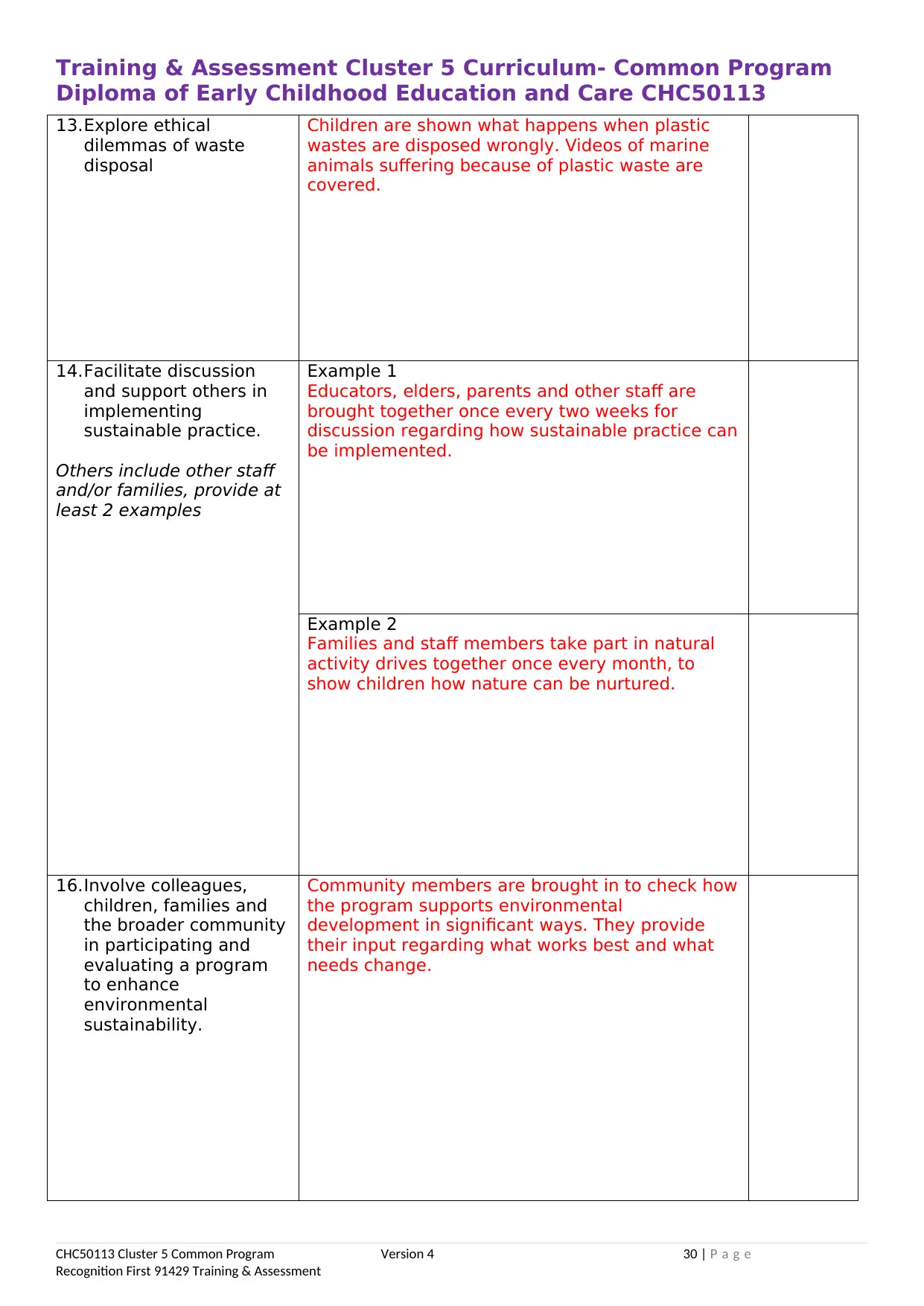
Training & Assessment Cluster 5 Curriculum- Common Program
Diploma of Early Childhood Education and Care CHC50113
13.Explore ethical
dilemmas of waste
disposal
Children are shown what happens when plastic
wastes are disposed wrongly. Videos of marine
animals suffering because of plastic waste are
covered.
14.Facilitate discussion
and support others in
implementing
sustainable practice.
Others include other staff
and/or families, provide at
least 2 examples
Example 1
Educators, elders, parents and other staff are
brought together once every two weeks for
discussion regarding how sustainable practice can
be implemented.
Example 2
Families and staff members take part in natural
activity drives together once every month, to
show children how nature can be nurtured.
16.Involve colleagues,
children, families and
the broader community
in participating and
evaluating a program
to enhance
environmental
sustainability.
Community members are brought in to check how
the program supports environmental
development in significant ways. They provide
their input regarding what works best and what
needs change.
CHC50113 Cluster 5 Common Program Version 4 30 | P a g e
Recognition First 91429 Training & Assessment
Diploma of Early Childhood Education and Care CHC50113
13.Explore ethical
dilemmas of waste
disposal
Children are shown what happens when plastic
wastes are disposed wrongly. Videos of marine
animals suffering because of plastic waste are
covered.
14.Facilitate discussion
and support others in
implementing
sustainable practice.
Others include other staff
and/or families, provide at
least 2 examples
Example 1
Educators, elders, parents and other staff are
brought together once every two weeks for
discussion regarding how sustainable practice can
be implemented.
Example 2
Families and staff members take part in natural
activity drives together once every month, to
show children how nature can be nurtured.
16.Involve colleagues,
children, families and
the broader community
in participating and
evaluating a program
to enhance
environmental
sustainability.
Community members are brought in to check how
the program supports environmental
development in significant ways. They provide
their input regarding what works best and what
needs change.
CHC50113 Cluster 5 Common Program Version 4 30 | P a g e
Recognition First 91429 Training & Assessment
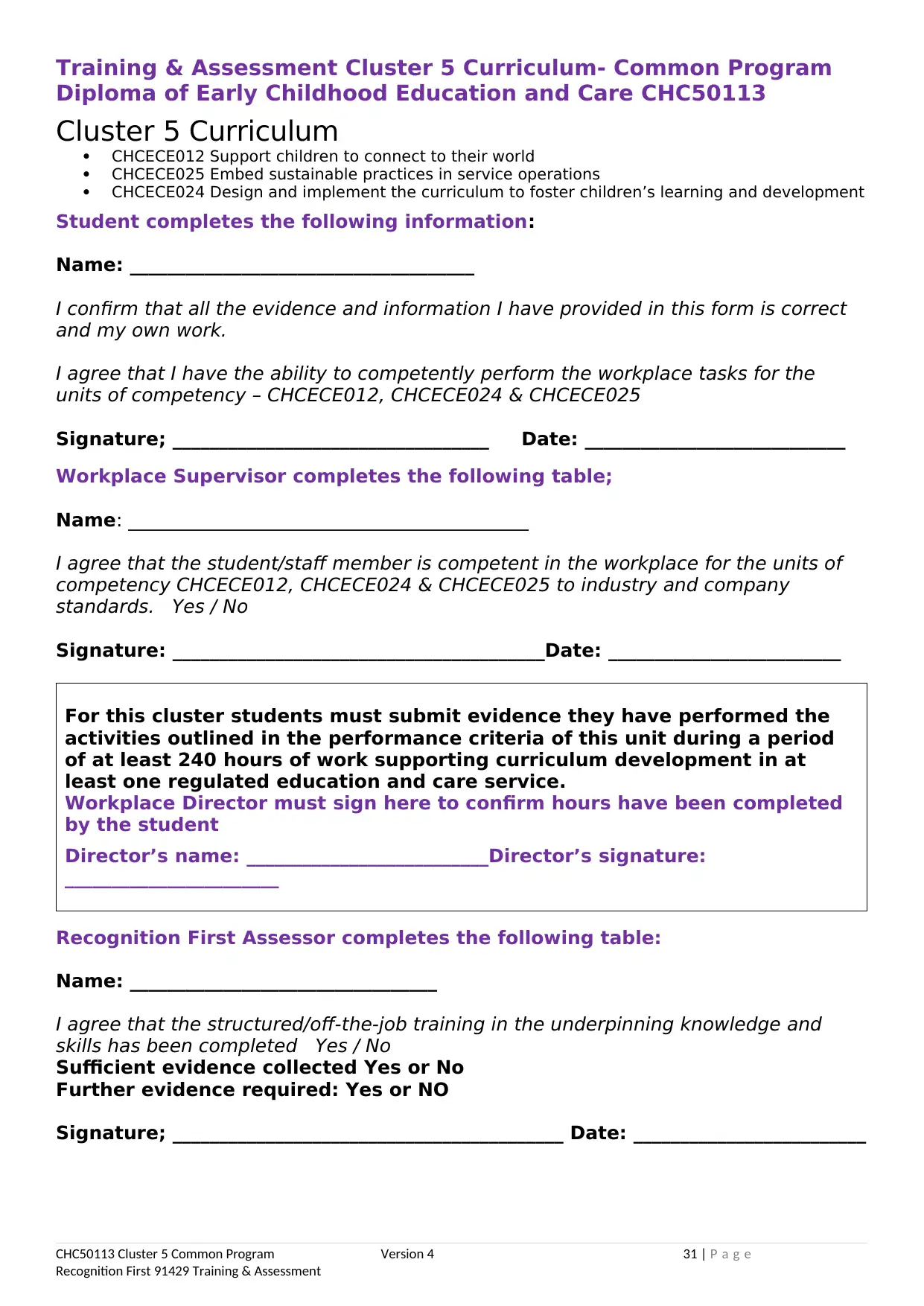
Training & Assessment Cluster 5 Curriculum- Common Program
Diploma of Early Childhood Education and Care CHC50113
Cluster 5 Curriculum
CHCECE012 Support children to connect to their world
CHCECE025 Embed sustainable practices in service operations
CHCECE024 Design and implement the curriculum to foster children’s learning and development
Student completes the following information:
Name: _____________________________________
I confirm that all the evidence and information I have provided in this form is correct
and my own work.
I agree that I have the ability to competently perform the workplace tasks for the
units of competency – CHCECE012, CHCECE024 & CHCECE025
Signature; __________________________________ Date: ____________________________
Workplace Supervisor completes the following table;
Name: ___________________________________________
I agree that the student/staff member is competent in the workplace for the units of
competency CHCECE012, CHCECE024 & CHCECE025 to industry and company
standards. Yes / No
Signature: ________________________________________Date: _________________________
For this cluster students must submit evidence they have performed the
activities outlined in the performance criteria of this unit during a period
of at least 240 hours of work supporting curriculum development in at
least one regulated education and care service.
Workplace Director must sign here to confirm hours have been completed
by the student
Director’s name: __________________________Director’s signature:
_______________________
Recognition First Assessor completes the following table:
Name: _________________________________
I agree that the structured/off-the-job training in the underpinning knowledge and
skills has been completed Yes / No
Sufficient evidence collected Yes or No
Further evidence required: Yes or NO
Signature; __________________________________________ Date: _________________________
CHC50113 Cluster 5 Common Program Version 4 31 | P a g e
Recognition First 91429 Training & Assessment
Diploma of Early Childhood Education and Care CHC50113
Cluster 5 Curriculum
CHCECE012 Support children to connect to their world
CHCECE025 Embed sustainable practices in service operations
CHCECE024 Design and implement the curriculum to foster children’s learning and development
Student completes the following information:
Name: _____________________________________
I confirm that all the evidence and information I have provided in this form is correct
and my own work.
I agree that I have the ability to competently perform the workplace tasks for the
units of competency – CHCECE012, CHCECE024 & CHCECE025
Signature; __________________________________ Date: ____________________________
Workplace Supervisor completes the following table;
Name: ___________________________________________
I agree that the student/staff member is competent in the workplace for the units of
competency CHCECE012, CHCECE024 & CHCECE025 to industry and company
standards. Yes / No
Signature: ________________________________________Date: _________________________
For this cluster students must submit evidence they have performed the
activities outlined in the performance criteria of this unit during a period
of at least 240 hours of work supporting curriculum development in at
least one regulated education and care service.
Workplace Director must sign here to confirm hours have been completed
by the student
Director’s name: __________________________Director’s signature:
_______________________
Recognition First Assessor completes the following table:
Name: _________________________________
I agree that the structured/off-the-job training in the underpinning knowledge and
skills has been completed Yes / No
Sufficient evidence collected Yes or No
Further evidence required: Yes or NO
Signature; __________________________________________ Date: _________________________
CHC50113 Cluster 5 Common Program Version 4 31 | P a g e
Recognition First 91429 Training & Assessment
1 out of 31
Related Documents
Your All-in-One AI-Powered Toolkit for Academic Success.
+13062052269
info@desklib.com
Available 24*7 on WhatsApp / Email
![[object Object]](/_next/static/media/star-bottom.7253800d.svg)
Unlock your academic potential
© 2024 | Zucol Services PVT LTD | All rights reserved.





